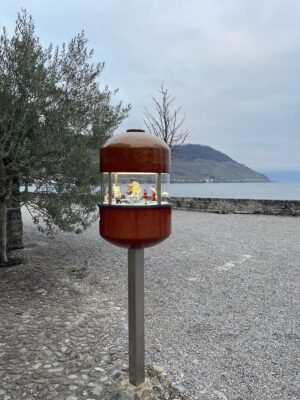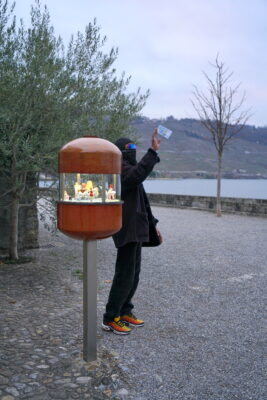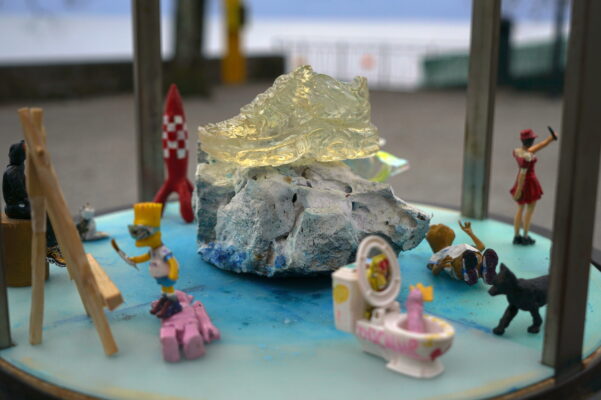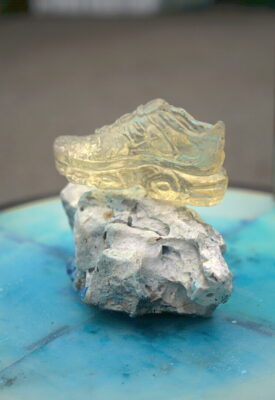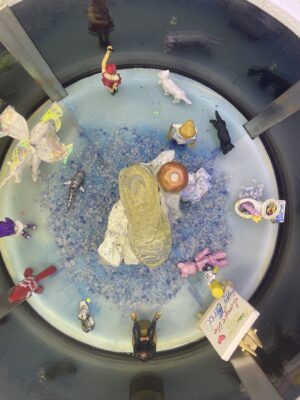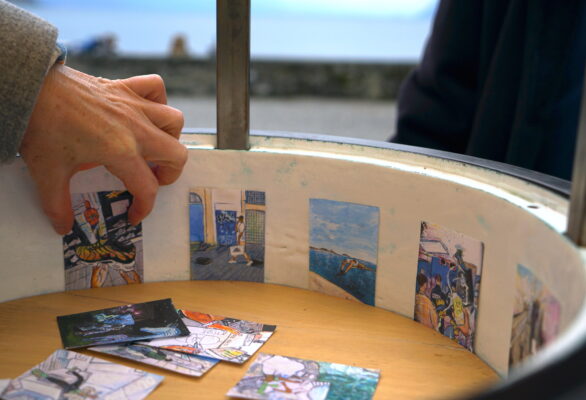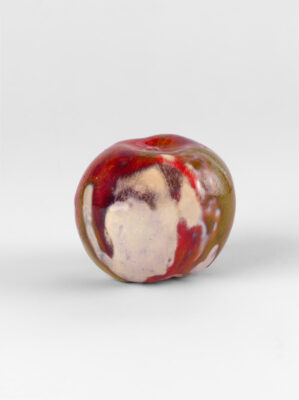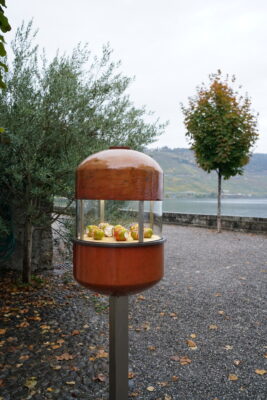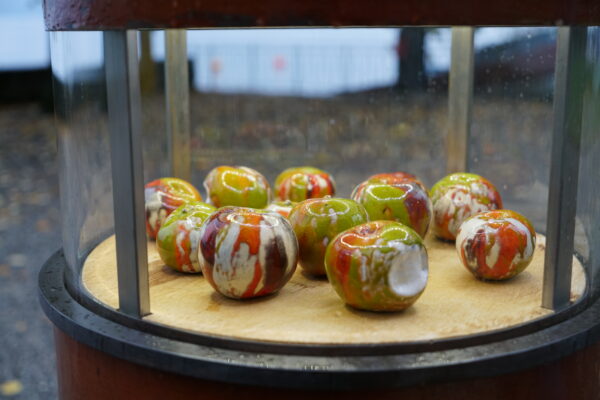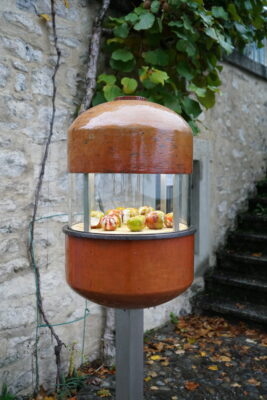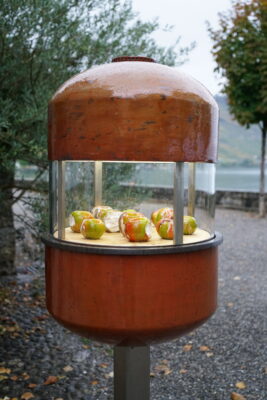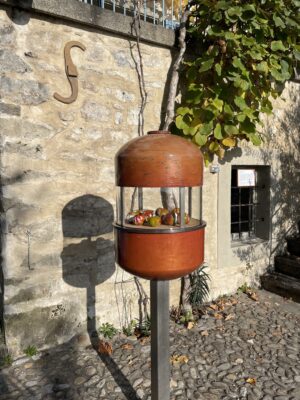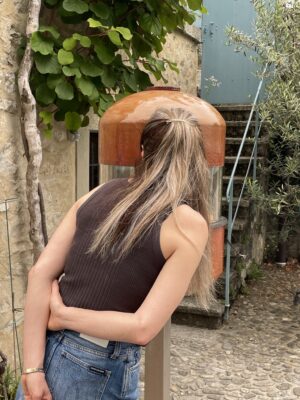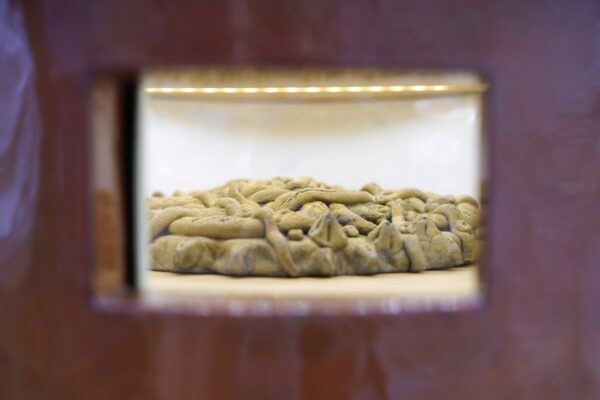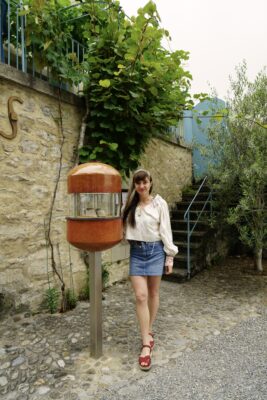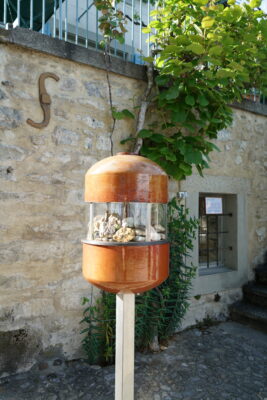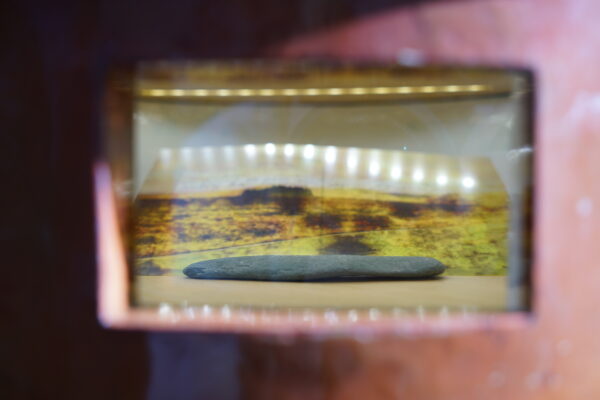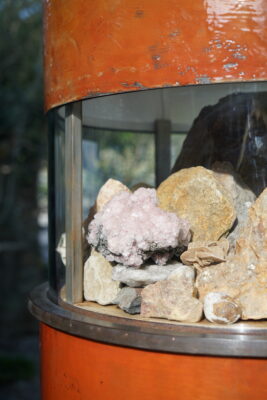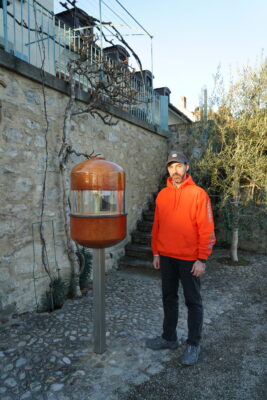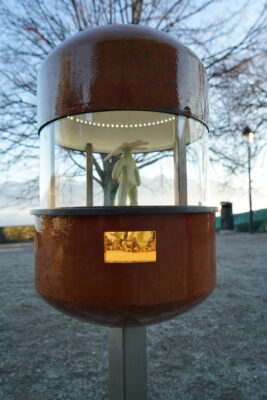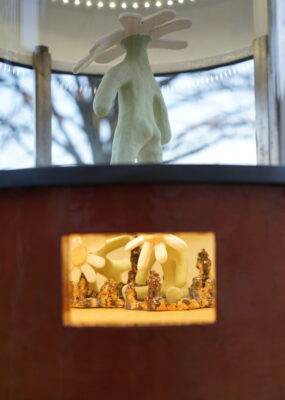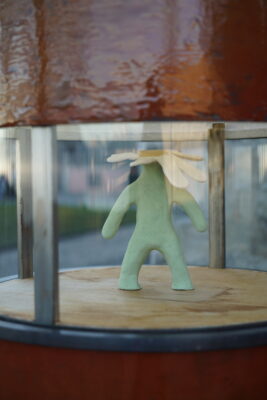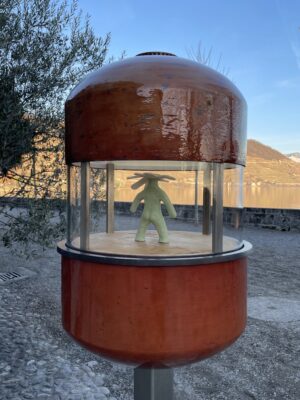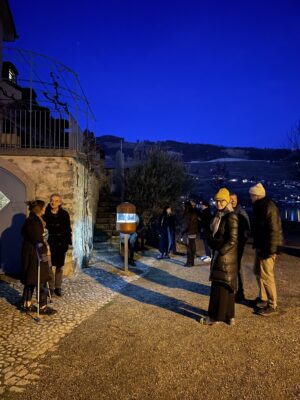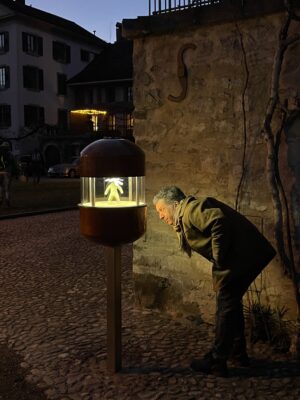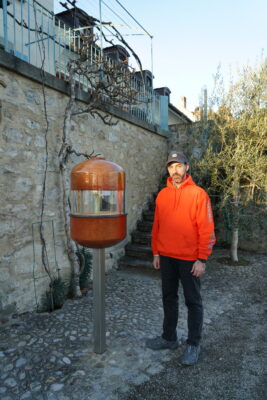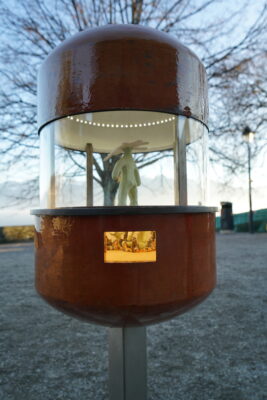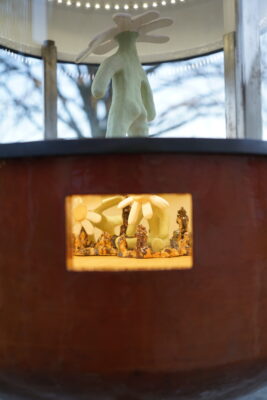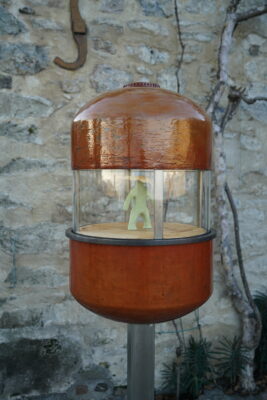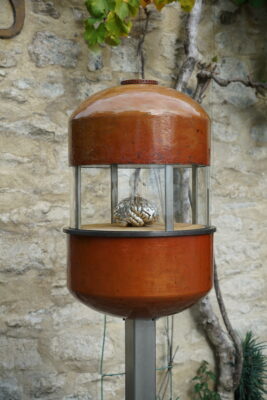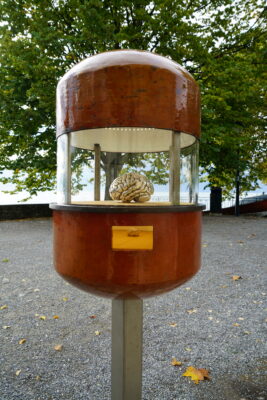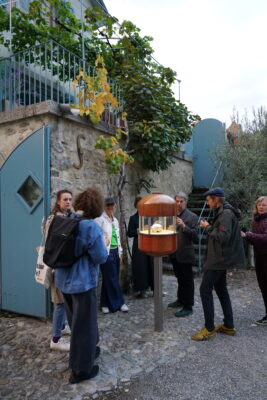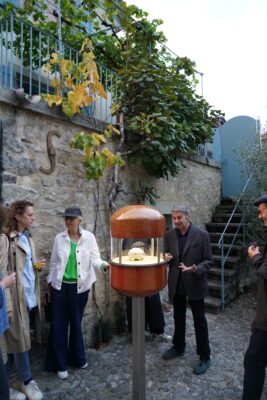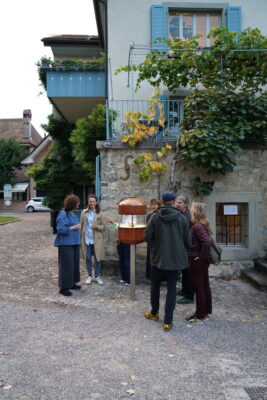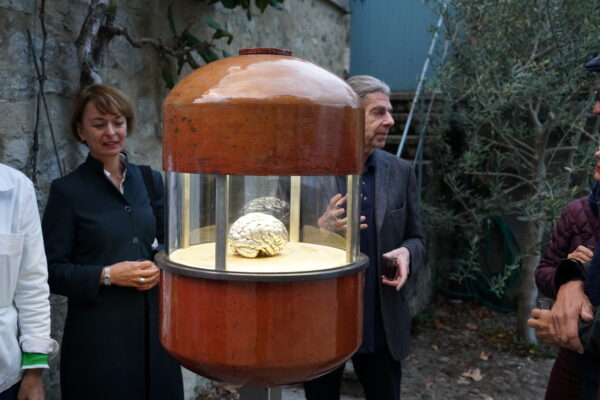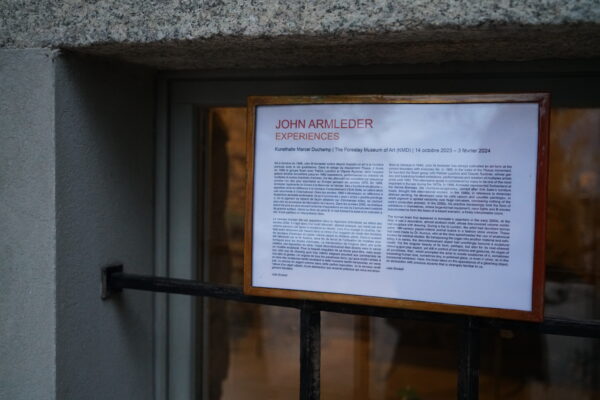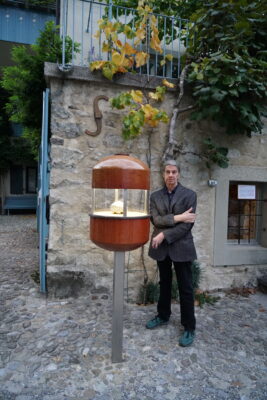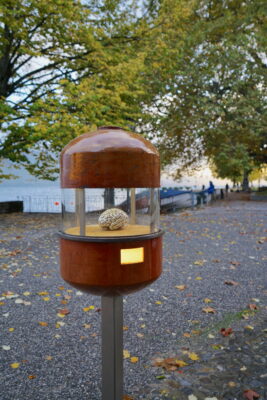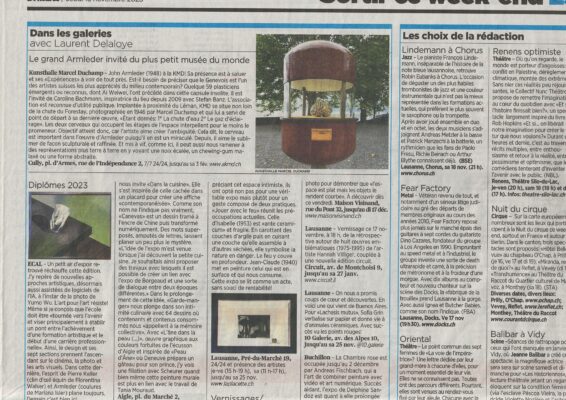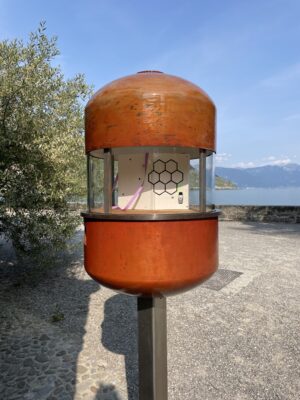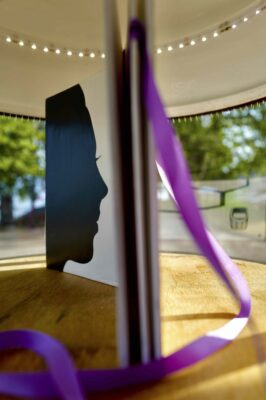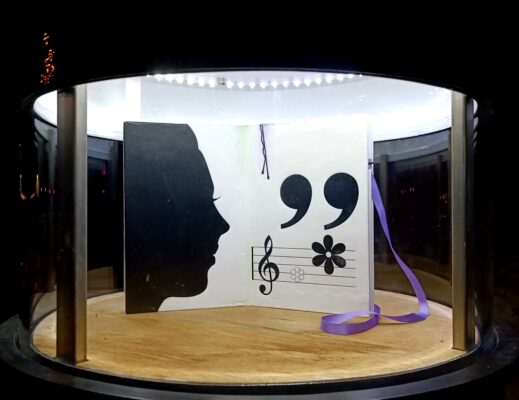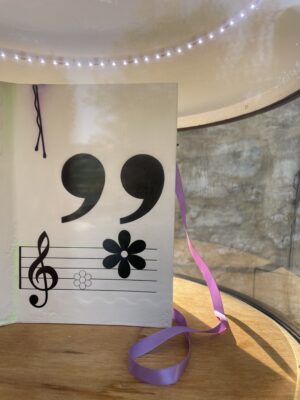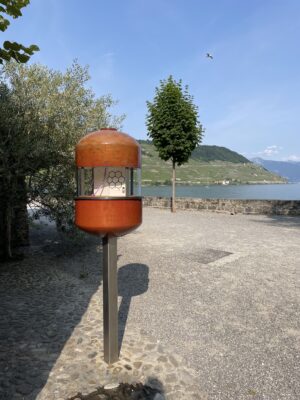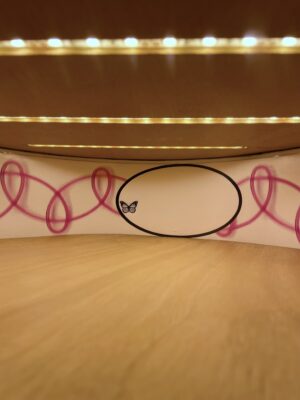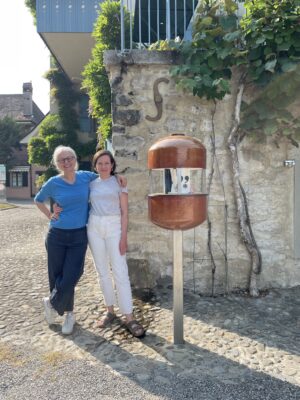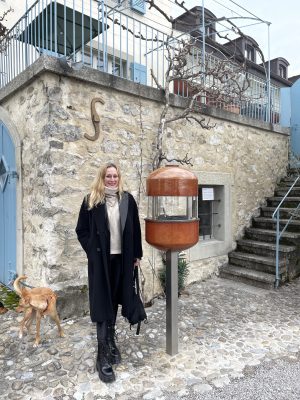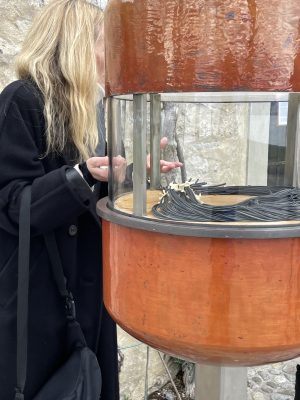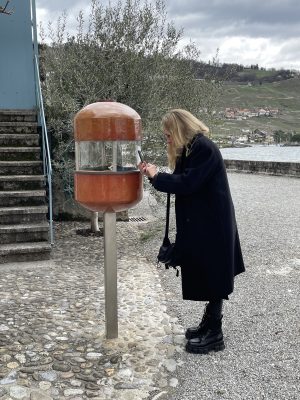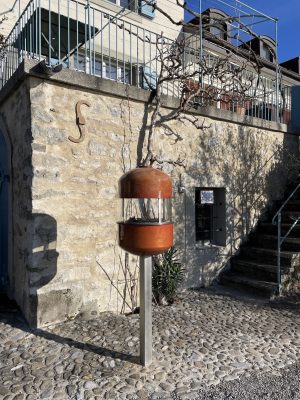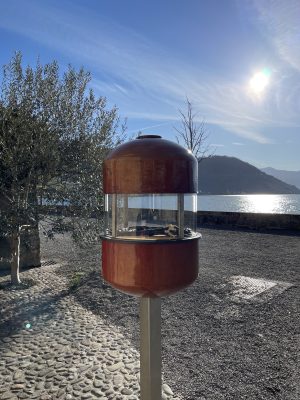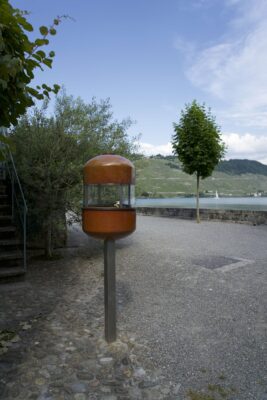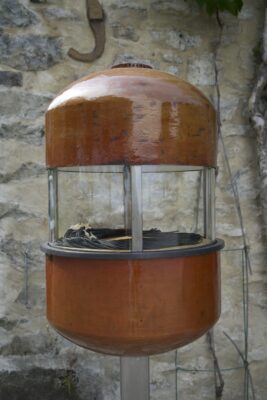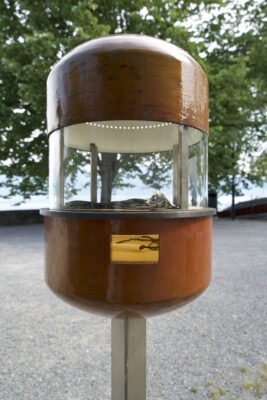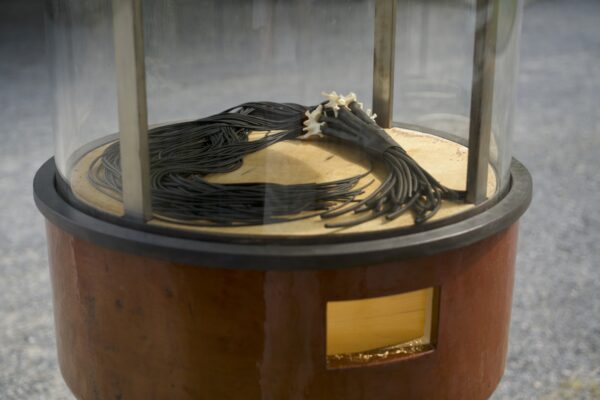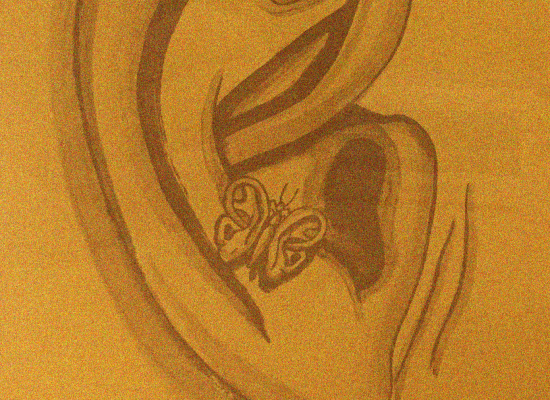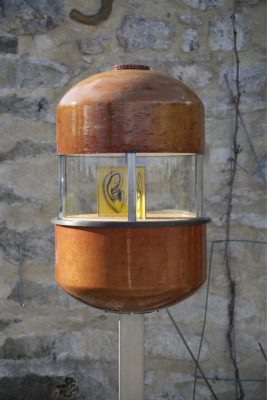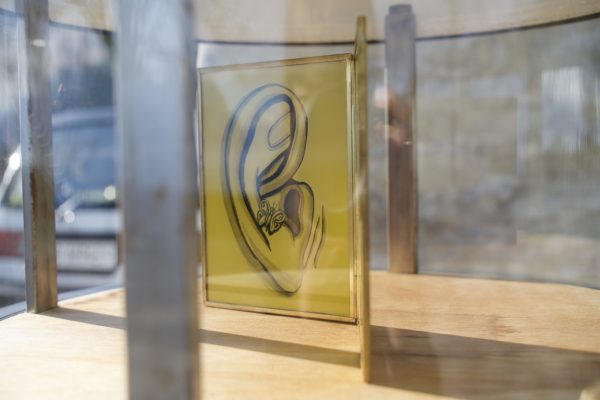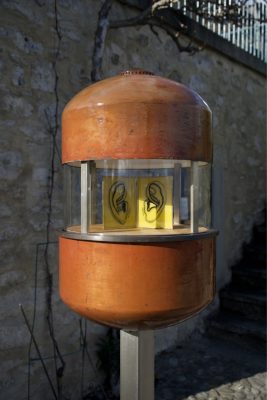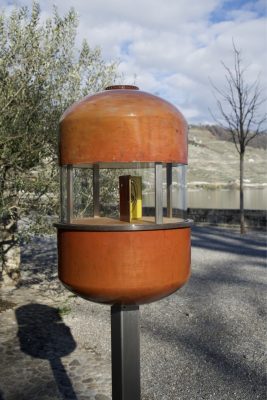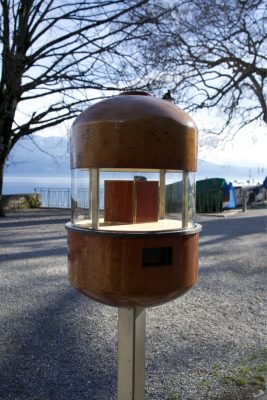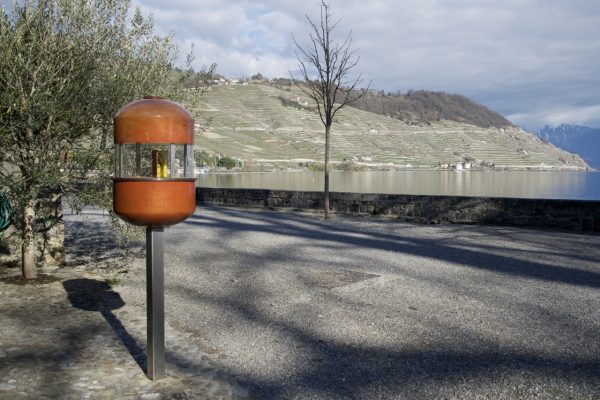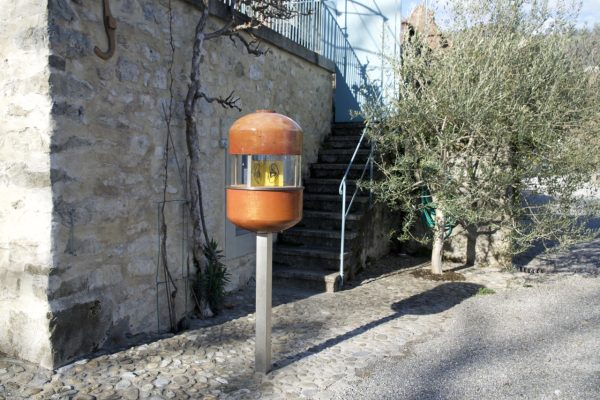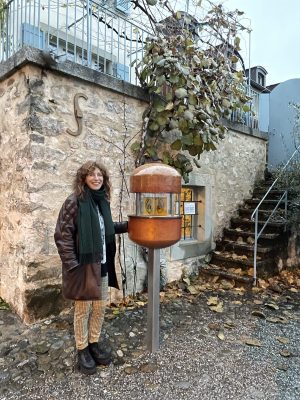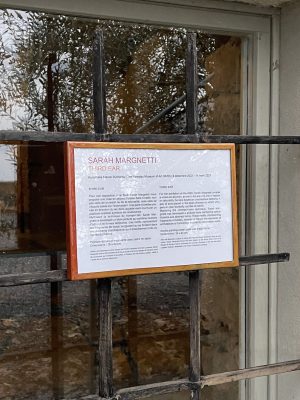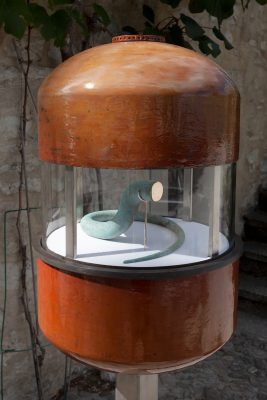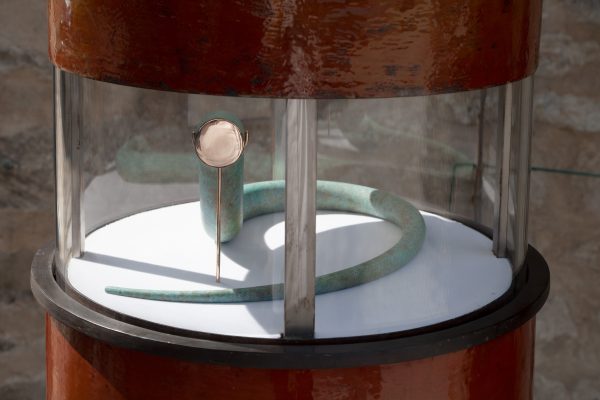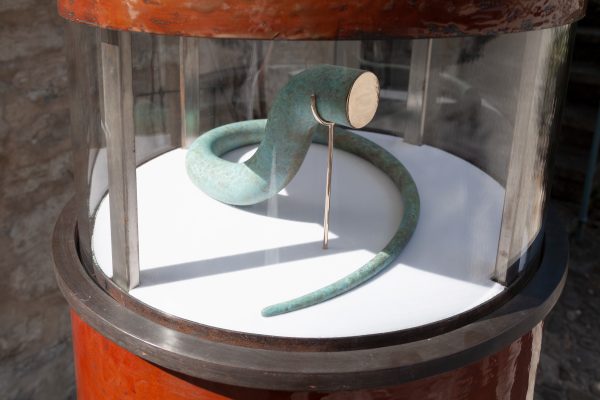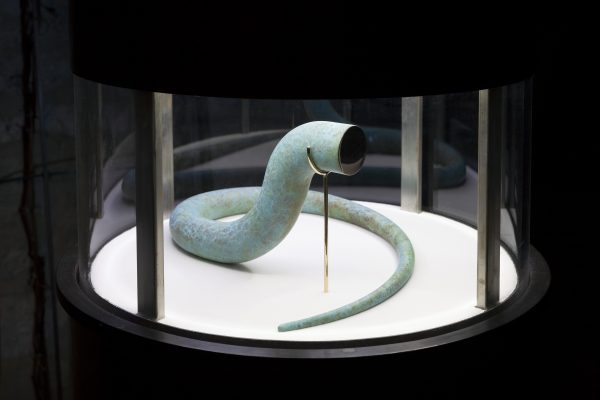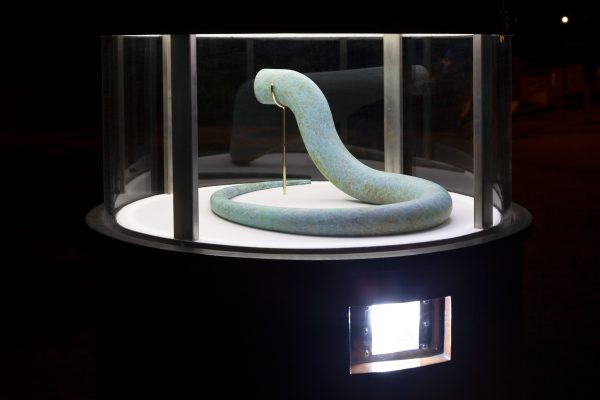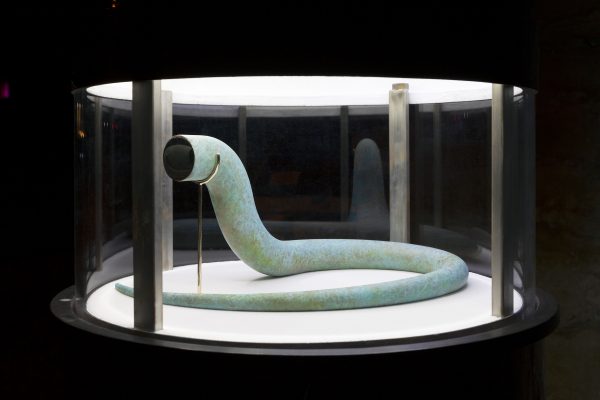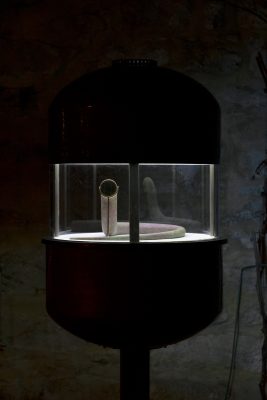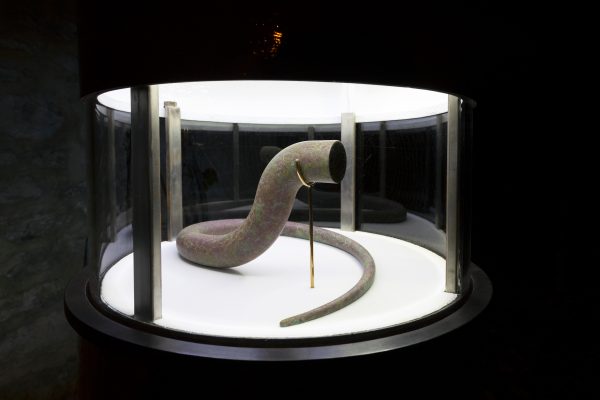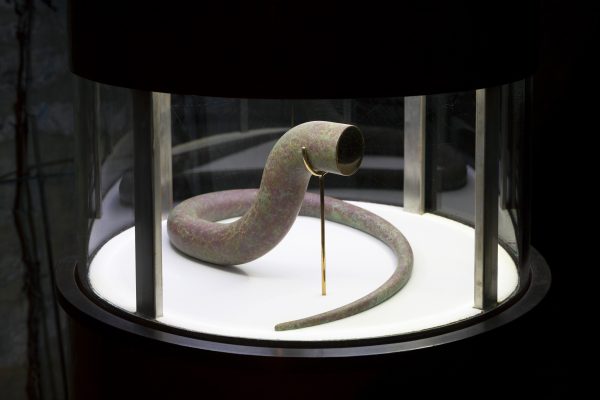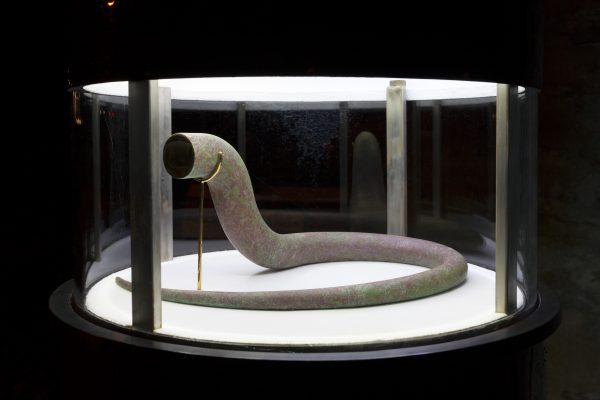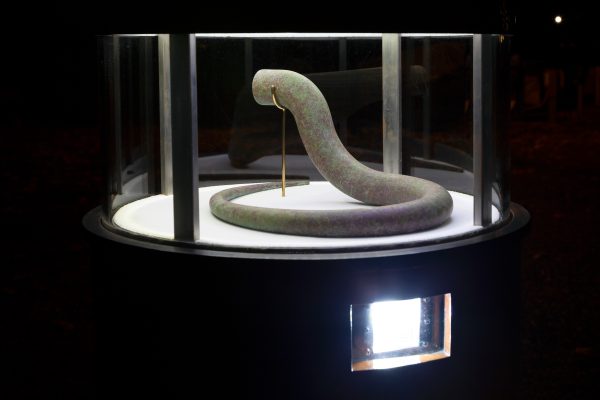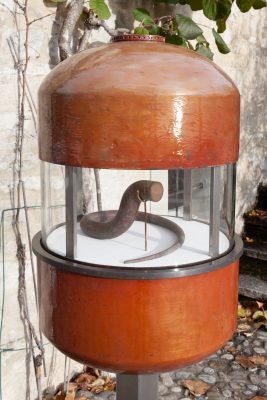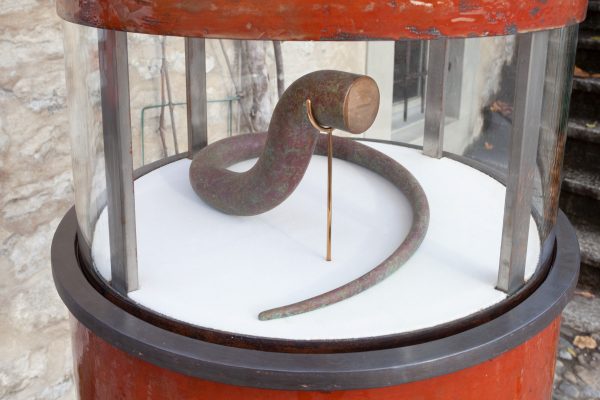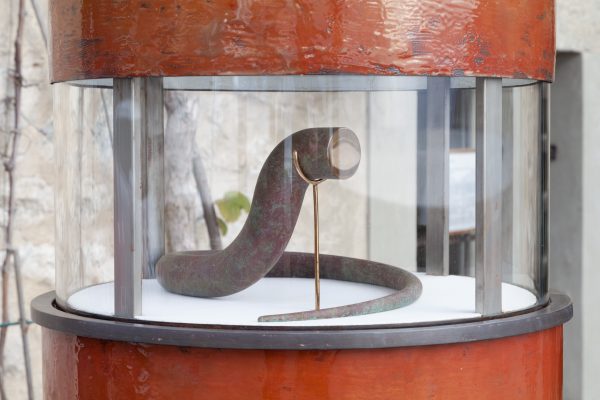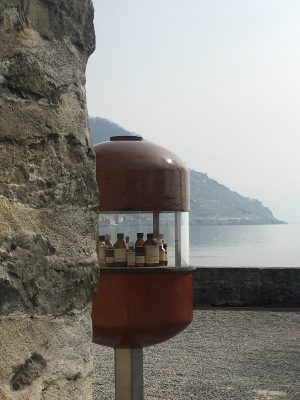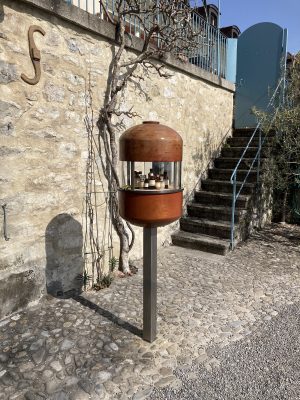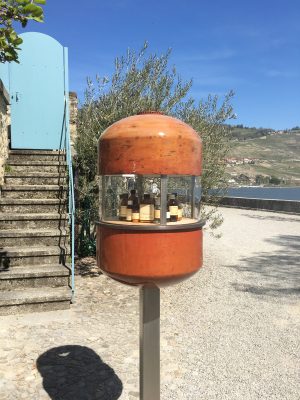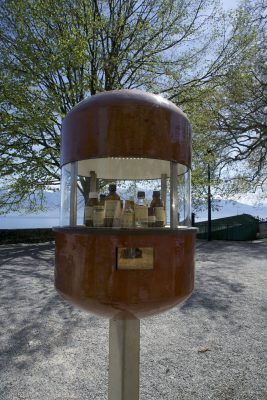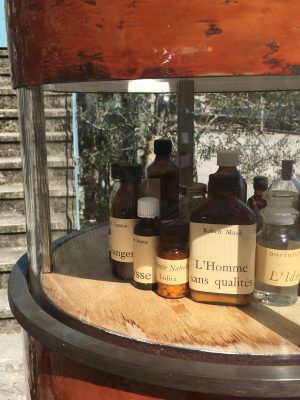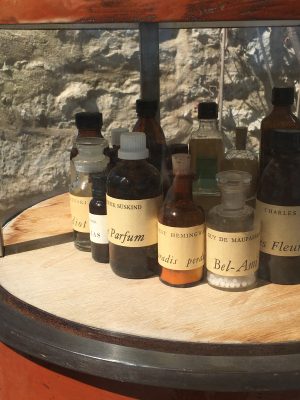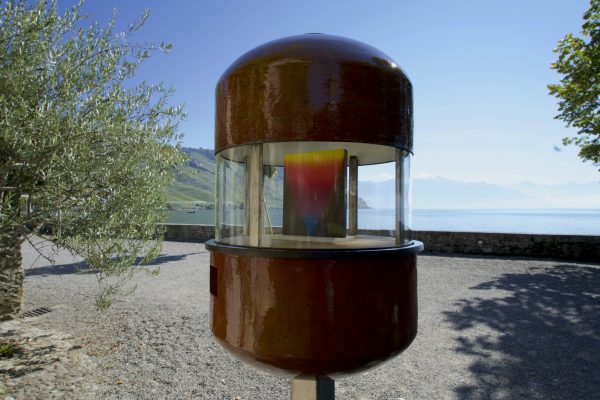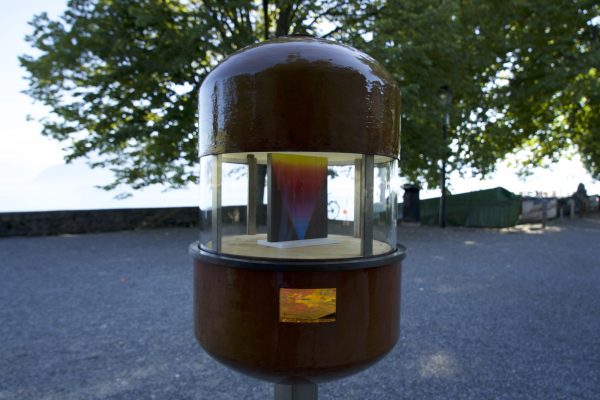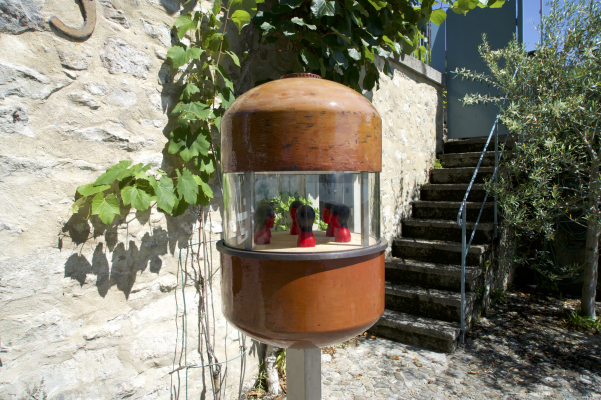66
N’zo C’est Du Gâteau
MARSEILLE DUCHAMP
February 1st, 2025 to May 31, 2025
Opening times : 24/24, from Mondays to Sundays
MARSEILLE DUCHAMP (eng)
For this exhibition at KMD, N’ZO creates a bridge between his hometown of Marseille and Switzerland, using clichés as part of a broader discourse on culture and identity. This approach reflects his vision of art in perpetual motion, driven by a quest for meaning and connection. He draws symbolic elements from reality, reflecting fragments of a complex Marseilles identity, nurtured by effervescent youth, but also exposed to varied and often dramatic forms of violence.
Faced with this reality, N’zo responds with a creative energy fueled by an infinite source of color and light. This vibrant energy, driven by contradictory emotions, embodies the uniqueness of Marseille. It unfolds through creations that bear witness to the richness of its roots, while seeking to build bridges between different cultures.
Here, the artist invites the public on a journey where he boldly explores the idea that the link – whether between the individual and his culture, between communities, or between oneself and one’s destiny – is essential to all human and artistic fulfillment. N’zo encourages us to question our own symbols, our roots and the paths we choose.
It’s not a question of moving away from Marseille, which is part of its DNA, but rather of proposing an original and intimate vision of it, while connecting it to other horizons. The exhibition, far from being a point of arrival, becomes a space of exchange where cultures, beliefs and passions are invited to meet.
Born in Marseilles in 1996, N’ZO C’DG is a self-taught visual artist who develops a free and experimental practice. He works with a range of artists including graffiti artist 3TTAM, Dutch collective Werker, painter SAEIO and Spanish collective Democracia. He took part in the group exhibition BtoB (2018), at the MUCEM in Marseille, and in the Werker collective’s publication, ‘Apprendre à ne pas travailler’ (Learning not to work) (2019). The FRAC Paca is including in its permanent collection its very first fanzine, La Bandite (2022), produced during a residency on site and published by the ‘Copie machine’ collective.
N’ZO develops a practice of drawing, painting, sculpture and performance. He works on the representation of the essence of Marseilles, with its gentle and violent energy, an image that both attracts and repels. He explores this narrative and takes it out of its reality, almost caricaturing it. His characters (who are often his own doubles) are the abstract incarnations of a collective identity that is both pleasurable and painful, situated between the sun of the south and a precarious daily life far from the tourists and the spotlights.
MARSEILLE DUCHAMP (fr)
Pour cette exposition à la KMD, N’ZO tisse un pont entre sa ville d’origine, Marseille, et la Suisse, en utilisant les clichés comme éléments d’un discours plus large sur la culture et l’identité. Cette démarche reflète sa vision d’un art en perpétuel mouvement, porté par une quête de sens et de connexion. Il puise dans le réel des éléments symboliques qui reflètent les fragments d’une identité marseillaise complexe, nourrie par une jeunesse effervescente, mais aussi exposée à des formes de violence variées.
Face à cette réalité, N’zo répond par une énergie créatrice irriguée par une source infinie de couleurs et de lumière. Cette énergie vibrante, portée par des émotions contradictoires, incarne la singularité de Marseille. Elle se déploie à travers des créations qui témoignent de la richesse de ses racines, tout en cherchant à établir des ponts entre différentes cultures.
L’artiste invite ici le public à un voyage où il explore, avec audace, l’idée que le lien – qu’il soit entre l’individu et sa culture, entre les communautés, ou entre soi et son destin – est essentiel à tout épanouissement humain et artistique. N’zo nous pousse à remettre en question nos propres symboles, nos ancrages et les chemins que nous choisissons.
Il n’est pas question de s’éloigner de Marseille qui fait partie de son ADN, mais bien d’en proposer une vision originale et intime, tout en la connectant à d’autres horizons. L’exposition, loin d’être un point d’arrivée, devient un espace d’échange où cultures, croyances et passions sont invitées à se rencontrer.
Né en 1996 à Marseille, N’ZO C’DG est un artiste plasticien autodidacte qui développe une pratique libre et expérimentale. Il collabore avec différents artistes tel que le graffeur 3TTAM, le collectif hollandais Werker, le peintre SAEIO et le collectif espagnol Democracia. Il participe à l’exposition collective BtoB (2018), au MUCEM, à Marseille et à l’édition du collectif Werker, « Apprendre à ne pas travailler » (2019). Le FRAC Paca fait entrer dans sa collection permanente son tout premier fanzine, La Bandite (2022), réalisé en résidence sur place et édité par le collectif “Copie machine”.
N’ZO développe une pratique du dessin, de la peinture, de la sculpture et de la performance. Il travaille sur la représentation d’une essence marseillaise à l’énergie douce et violente et dont l’image attire et repousse à la fois. Il explore ce récit et le sort de sa réalité en le caricaturant presque. Ses personnages (qui sont souvent ses propres doubles) sont les incarnations abstraites d’une identité collective à la fois jouissive et douloureuse, qui se situe entre le soleil du sud et un quotidien précaire loin des touristes et des projecteurs.

65
Mai-Thu Perret
MOONMILK
October 13, 2024 to January 25, 2025
Opening times : 24/24, from Mondays to Sundays
MOONMILK (eng)
Known for her multidisciplinary practice including installation, performance, sculpture, ceramics and textiles, Mai-Thu Perret’s work draws on a range of twentieth-century artistic movements, including Dada, Constructivism and Bauhaus. The piece Do not think at all about good and bad is part of her research into the treatment of women, in this case through the prism of witchcraft. A recurring motif in the artist’s work is the imagery of the apple, it here refers both to Eve’s consumption of the forbidden fruit in the Garden of Eden and Snow White’s poisoned apple. In her book Caliban and the Witch, Marxist feminist historian Silvia Federici argues that the demonisation of the figure of the witch in society emerged during the transition from feudalism to capitalism; witch hunts were used to systematically oppress self-sufficient women who represented an obstacle to the destruction of the commons, and to discipline the peasantry so that they would become a servile workforce in the service of the new capitalist system.
The title Moonmilk is a poetic evocation of feminine magic. It refers to the moon, milk and motherhood, but also to the cave, which brings with it a whole series of associations linked to this way of life, as well as the maternal womb and so on.
The second piece is a small mound of pink ceramic from which emerges the head of a nocturnal animal, perhaps a cat or an owl.
Julie Enckell
Mai-Thu Perret was born in 1976 in Geneva, Switzerland, where she lives and works. She studied at Cambridge University and the Whitney Independent Study Program in New York. In 2018, she was awarded the Paul Boesch Art Prize, in Bern, Switzerland. She has recently had solo exhibitions at Galerie Elisabeth & Klaus Thoman, Innsbruck (2022), Insituto Svizzero, Rome (2022), Centre d’édition contemporaine, Geneva (2022), Portique – Centre régional d’art contemporain du Havre, Le Havre (2020), Badischer Kunstverein, Karlsruhe (2022) and Institute for Contemporary Art; Badischer Kunstverein, Karlsruhe (2019); Spike Island, Bristol (2019); MAMCO, Geneva (2018, 2011); Nasher Sculpture Center, Dallas (2016); Kunsthaus Aarau (2011); Le Magasin, Grenoble (2011) and The Renaissance Society, Chicago (2006). In 2011, she took part in the ILLUMInations exhibition at the 54th Venice Biennale, Venice, Italy, curated by Bice Curiger.
MOONMILK (fr)
Connue pour sa pratique pluridisciplinaire qui englobe l’installation, la performance, la sculpture, la céramique et le textile, Mai-Thu Perret nourrit son travail d’une série de mouvements artistiques du XXe siècle dont Dada, le constructivisme ou encore le Bauhaus. La pièce Do not think at all about good and bad s’inscrit dans le cadre de ses recherches sur le traitement des femmes, en l’occurrence à travers le prisme de la sorcellerie. Motif récurrent du travail de l’artiste, l’imagerie de la pomme fait ici référence à la fois à la consommation du fruit défendu par Ève dans le jardin d’Éden et à la pomme empoisonnée de Blanche-Neige. Dans son ouvrage Caliban et la sorcière, l’historienne marxiste féministe Silvia Federici affirme que la diabolisation de la figure de la sorcière dans la société est apparue lors de la transition du féodalisme au capitalisme ; les chasses aux sorcières étaient utilisées pour opprimer systématiquement les femmes autosuffisantes qui représentaient un obstacle à la destruction des biens communs, et pour discipliner la paysannerie afin qu’elle devienne une force de travail servile au service du nouveau système capitaliste.
Le titre Moonmilk est à comprendre de façon poétique comme une évocation de la magie féminine. Il fait référence à la lune, au lait, à la maternité, mais aussi à l’évocation de la caverne, qui entraine avec elle toute une série d’associations liées à ce mode de vie, mais aussi le ventre maternel, etc.
La deuxième pièce est un petit monticule de céramique rose dont émerge une tête d’animal nocturne, peut-être un chat ou un hibou.
Julie Enckell
Mai-Thu Perret est née en 1976 à Genève, en Suisse, où elle vit et travaille. Elle a étudié à l’université de Cambridge et au Whitney Independent Study Program, à New York. En 2018, elle a reçu le Paul Boesch Art Prize, à Berne, en Suisse. Elle a récemment exposé en solo à la Galerie Elisabeth & Klaus Thoman, Innsbruck (2022), à l’Insituto Svizzero, Rome (2022), au Centre d’édition contemporaine, Genève (2022), au Portique – Centre régional d’art contemporain du Havre, Le Havre (2020), au Badischer Kunstverein, Karlsruhe (2022) et à l’Institut de l’art contemporain ; Badischer Kunstverein, Karlsruhe (2019) ; Spike Island, Bristol (2019) ; MAMCO, Genève (2018, 2011) ; Nasher Sculpture Center, Dallas (2016) ; Kunsthaus Aarau (2011) ; Le Magasin, Grenoble (2011) et The Renaissance Society, Chicago (2006). En 2011, elle a participé à l’exposition ILLUMInations à la 54e Biennale de Venise, Venise, Italie, sous la direction de Bice Curiger.

64
Valérie Mannaerts
TENDER VESSEL
June 29, 2024 to August 31, 2024
Opening times : 24/24, from Mondays to Sundays
TEDNER VESSEL (eng)
One of Valérie Mannaerts artistic question is the evocative power of objects, the possible stories they contain, what they hide or suggest about our actions or the ages of humanity. The canvas shoes that the artist has sewn together hark back to childhood, or perhaps to that in-between age when we are preparing to leave one world for another. Sketched shoes, as vulnerable as the yellowed tutu of Degas’ Dancer, contrasting with the patinated, unchanging, heavy bronze inside. They evoke a lost time, an absence, even a certain destitution, while what they contain suggests wealth and eternity. They are thus inevitably marked by the passage of time, and are displayed here as relics, witnessing the existence of anonymous beings.
On the lower floor, the pastry transposed into bronze reverses the value of the object, giving it a durability it does not have. The piece is inspired by resin dishes – often seen in Japan when displaying food – but also alludes to the ritual of passing on a gesture repeated over generations.
Julie Enckell
Valérie Mannaerts (*1974, lives and works in Brussels and Geneva) is a sculptor and painter. Her work, which takes the form of installations and scenographies, question the status of objects. Her work, reminiscent of surrealist, and later feminist, concerns about material culture and image, corporeality and states of consciousness. Using a variety of materials, she creates hybrid, undisciplined sculptures and paintings in which she questions the relationship between organic and inorganic forms. In her work, Valérie Mannaerts explores the work of art as a site of freedom, resistance and invention.
TENDER VESSEL (fr)
Il y a, parmi les questionnements artistiques de Valérie Mannaerts, celui de la puissance évocatrice des objets, ce qu’ils contiennent de récits possibles, ce qu’ils cachent ou suggèrent de nos gestes ou des âges de l’humanité. Les chaussures en toiles que l’artiste a cousues renvoient ainsi au temps de l’enfance, ou peut-être à cet âge de l’entre-deux, où on s’apprête à quitter un monde pour un autre. Des chaussures esquissées, aussi vulnérables que le tutu jauni de la Danseuse de Degas, et qui contrastent avec le bronze patiné, immuable et lourd, logé à l’intérieur. Elles évoquent un temps perdu, une absence, un certain dénuement même, alors que ce qu’elles renferment suggère au contraire la richesse et l’éternité. Elles sont ainsi inévitablement marquées par le passage du temps, et sont exposées ici comme des vestiges, témoins de l’existence d’êtres anonymes.
À l’étage inférieur, la pâtisserie transposée en bronze renverse la valeur de l’objet et lui confère une durabilité qu’il n’a pas. La pièce s’inspire ici des plats en résine – que l’on voit souvent au Japon, lorsqu’il s’agit de présenter des aliments en vitrine – mais fait aussi allusion au rituel de transmission d’un geste répété au fil des générations.
Julie Enckell
Valérie Mannaerts (*1974 vit et travaille à Bruxelles et à Genève) est sculptrice et peintre. Son travail, qui se déploie comme des installations ou des scénographies, questionne le statut des objets. Son travail rappelle les préoccupations surréalistes, et plus tard féministes, concernant la culture matérielle et l’image, la corporéité et les états de conscience. En utilisant divers matériaux, elle crée des sculptures et des peintures hybrides, indisciplinées, dans lesquelles elle questionne la relation entre les formes organiques et inorganiques. Dans son travail, Valérie Mannaerts explore l’œuvre d’art en tant que site de liberté, de résistance et d’invention.

63
Emmanuelle Antille
HER EARTHS, HER HEARTH
May 4, 2024 to June 29, 2024
Opening times : 24/24, from Mondays to Sundays
HEAR EARTHS, HER HEARTH (eng)
For her exhibition at the KMD, Emmanuelle Antille extends the questioning of her latest film THE WONDER WAY around the creative gesture and the exploration of new territories.
Using her grandmother’s collections (her stones and her notebook listing all the films she had seen at the cinema) as material, Emmanuelle reorganises the elements to build a new territory, revealing her grandmother’s secret sources of inspiration and escape. Constructing a dreamed elsewhere (each stone, carefully labeled, had been brought back to her from the four corners of the globe by relatives), this amalgam of other bits and pieces of worlds forms a place of projection for so many possible wanderings and explorations. Playing with words – earth and hearth – as she glides from territory to home, Emmanuelle Antille highlights the intimate movements of a lifetime as the beginning of a primal desire for creation and transformation. A landscape dedicated to a woman who had hardly ever left her garden.
Technique: Minerals, paper, photo print on acetate film.
At the border between fiction and documentary, Emmanuelle Antille develops her artistic practice as both artist and filmmaker, questioning social codes and rituals, the creative process and transmission.
Her work has been shown at Kunstverein Frankfurt, Renaissance Society Chicago, Brooklyn Museum New York, National Gallery Reykjavik, CCA Glasgow, Toyko Wonder Site Tokyo, De Appel Amsterdam, Fredericianum Kassel, Migros Museum Zürich, Jeu de Paume and Musée d’Art Moderne de la Ville de Paris. In 2003, Emmanuelle Antille represented Switzerland in the national pavilion at the 50th Venice Biennale. In 2012, she directed AVANTI, a feature film starring Hanna Schygulla and Miou-Miou. In 2019, A BRIGHT LIGHT, her film about singer Karen Dalton, wins Best Documentary at San Sebastian’s Dock of The Bay. In 2023, she directed THE WONDER WAY, which won the Special Jury Prize at the Visions du Réel festival in Nyon.
HEAR EARTHS, HER HEARTH (fr)
Pour son exposition à la KMD, Emmanuelle Antille nous propose de prolonger le questionnement de son dernier film THE WONDER WAY autour du geste créatif et de l’exploration de territoires inédits. Avec pour matériau les collections de sa grand-mère (ses pierres et son carnet listant tous les films qu’elle avait vus au cinéma), Emmanuelle en réorganise les éléments pour construire un nouveau territoire, révélant ainsi les sources d’inspiration et échappatoires secrets de son aïeule. Construction d’un ailleurs rêvé (chaque pierre, soigneusement étiquetée, lui avait été rapportée des quatre coins du globe par des proches), cet amalgame d’autres bouts de mondes forment ici un lieu de projection pour autant de vagabondages et d’explorations possibles. Jouant avec les mots – earth et hearth – en glissant du territoire au foyer, Emmanuelle Antille met en lumière les mouvements intimes de toute une vie comme amorce d’un désir premier de création et de transformation. Un paysage dédié à celle qui n’avait pratiquement jamais quitté son jardin.
Technique : Minéraux, papier, impression photo sur film acétate.
À la frontière de la fiction et du documentaire, Emmanuelle Antille développe sa pratique artistique tant comme artiste que cinéaste, interrogeant codes sociaux et rituels, processus créatif et transmission.
Son travail a notamment été présenté au Kunstverein de Frankfurt, au Renaissance Society de Chicago, au Brooklyn Museum de New York, au National Gallery de Reykjavik, au CCA de Glasgow, au Toyko Wonder Site de Tokyo, au De Appel de Amsterdam, au Fredericianum de Kassel, au Migros Museum de Zürich, au Jeu de Paume et au Musée d’Art Moderne de la Ville de Paris. En 2003, Emmanuelle Antille représente la Suisse à la 50ème Biennale de Venise dans le pavillon national. En 2012, elle réalise AVANTI, un long-métrage de fiction avec Hanna Schygulla et Miou-Miou. En 2019, A BRIGHT LIGHT, son film sur la chanteuse Karen Dalton, reçoit le prix du meilleur documentaire au Dock of The Bay de San Sebastian. En 2023, elle réalise THE WONDER WAY, prix spécial du Jury à Visions du Réel à Nyon.
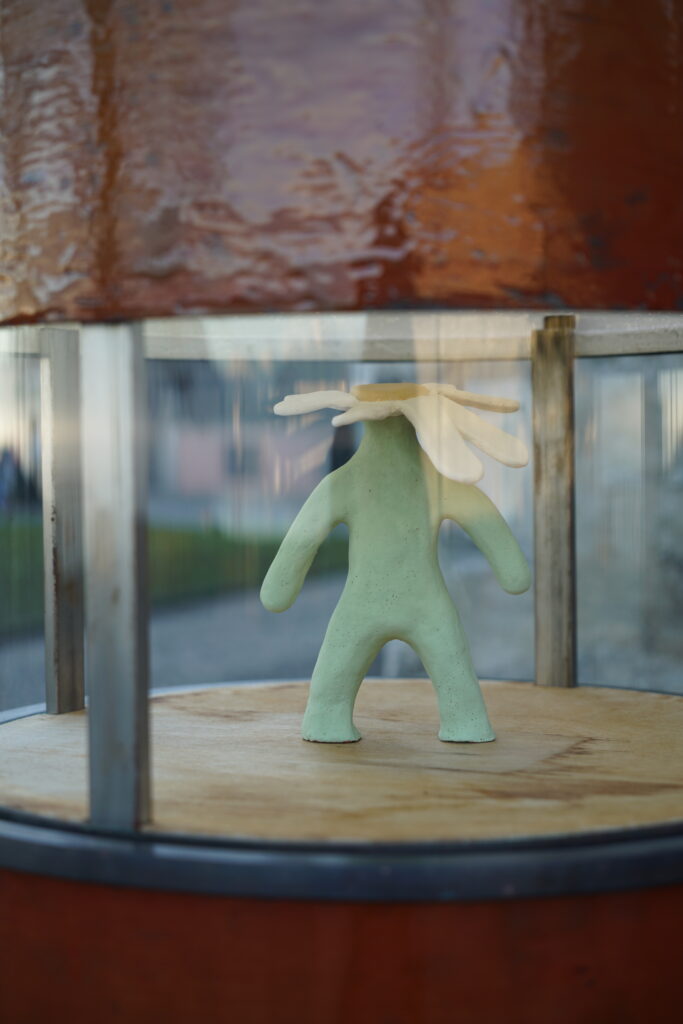
62
Guillaume Pilet
DEEP FLOWERS
February 4, 2024 to May 4, 2024
Opening times : 24/24, from Mondays to Sundays
DEEP FLOWERS (eng)
With Deep Flowers, Guillaume Pilet opens a new cycle in his work. After a cycle devoted to the figure of the monkey (Learning From Aping, 2010-2014), a series of works based on the notion of autobiography (La Mesure Harmonique, 2014-2019), performances, drawing and an opera, he is now turning his attention to psychoanalysis as an artistic device. Taking Françoise Dolto’s Poupée-Fleur (invented around 1949) as his inspiration, he hijacks the therapeutic object by giving it an «attitude». In this way, the projection based on a scientific document, in this case the Poupée-Fleur, is overturned by the addition of an erratic element. A game between the visible and the invisible, the empiricism of the method and the margin for interpretation. On the lower floor of the Kunsthalle, two small Flower Dolls interact in a primitive cave landscape, an intriguing element that makes the introspection all the more mythological. The duo, a kind of mini society, thwart the self-centred system by suggesting that there could be many more, and that they could be activated in the way of a cartoon. These statuettes, objects of transfer, play with theatricality and scale. Guillaume Pilet likes to draw parallels between the ‘functional’ therapy tool and the art object, onto which we can project all sorts of interpretations.
Technique: Engobed clay, glazed ceramics
Guillaume Pilet is an artist, critic and curator based in Lausanne. After graduating from ECAL (BFA 2007, MFA 2010), he co-directed the Forde art centre in Geneva from 2010 to 2012 and is a founding member of the Tunnel Tunnel art space in Lausanne. His work has been shown in solo exhibitions at the Centre culturel suisse in Paris, the Kunsthaus Glarus, the Musée cantonal des Beaux-Arts in Lausanne, Primary in Nottingham and the Kunsthalle São Paulo.
DEEP FLOWERS (fr)
Avec Deep Flowers, Guillaume Pilet ouvre un nouveau cycle de son travail. Après un volet consacré à la figure du singe (Learning From Aping, 2010-2014), une série de travaux autour de la notion d’autobiographie (La Mesure Harmonique, 2014-2019), des performances, du dessin, et un opéra ; il s’intéresse ici à la psychanalyse comme dispositif artistique. En reprenant la Poupée-Fleur de Françoise Dolto (inventée vers 1949), il détourne l’objet thérapeutique en lui conférant une «attitude ». Ainsi la projection basée sur un document scientifique, en occurrence la Poupée-Fleur, est bousculée par l’ajout d’un élément erratique. Un jeu entre ce qui est visible et invisible, l’empirisme de la méthode et la marge d’interprétation. À l’étage inférieure de la Kunsthalle, on retrouve deux petites Poupées-Fleurs qui interagissent dans un paysage de grotte primitive, un élément intrigant qui rend l’introspection d’autant plus mythologique. Le duo, sorte de mini société, vient déjouer le système autocentré en suggérant qu’il pourrait y en avoir bien plus, et qu’elles pourraient s’activer à la manière d’un dessin animé. Ces statuettes, objets de transfert, jouent de la théâtralité et de l’échelle. Guillaume Pilet se plaît à tirer le parallèle entre l’outil « fonctionnel » de thérapie et l’objet d’art sur lequel on vient, là aussi, projeter toutes sortes d’interprétations.
Technique : Terre cuite engobée, céramique émaillée
Guillaume Pilet est un artiste, critique et curateur basé à Lausanne. Diplômé de l’ECAL (BFA 2007, MFA 2010), il a co-dirigé le centre d’art Forde à Genève de 2010 à 2012 et est un membre fondateur de l’espace d’art Tunnel Tunnel à Lausanne. Son travail a notamment été présenté dans des expositions monographiques au Centre culturel suisse de Paris, au Kunsthaus de Glaris, au Musée cantonal des Beaux-Arts de Lausanne, à Primary à Nottingham et à la Kunsthalle São Paulo.
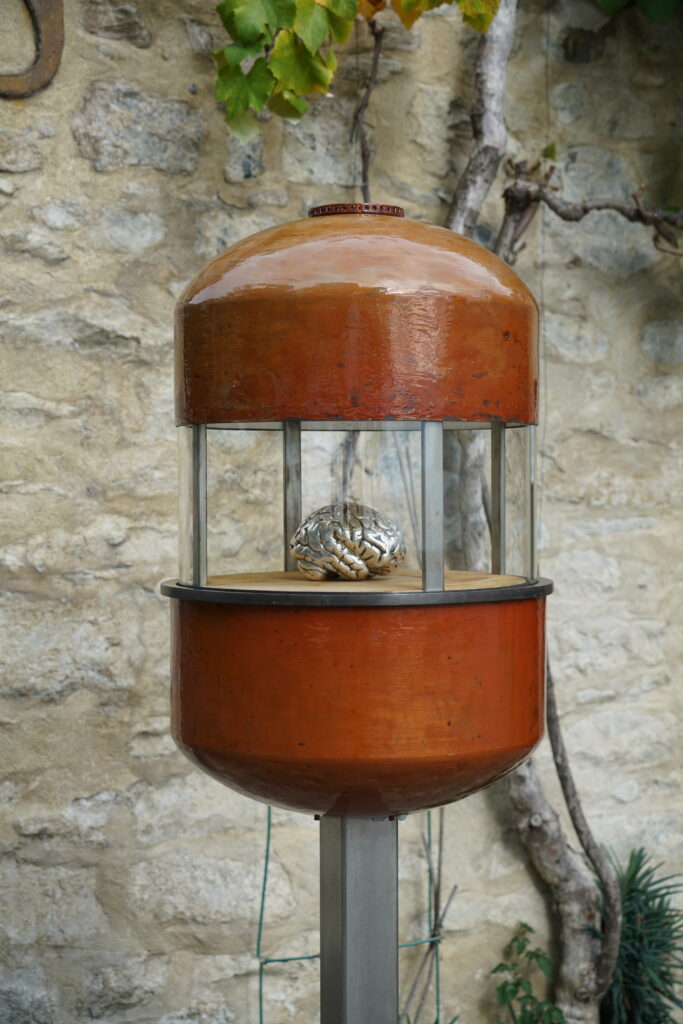
61
John Armleder
EXPERIENCES
October 14, 2023 to February 3, 2024
Opening times : 24/24, from Mondays to Sundays
EXPERIENCES (eng)
Born in Geneva in 1948, John M Armleder has always cultivated an art form at the porous boundary with everyday life. In 1969, in the wake of the Fluxus movement, he founded the Ecart group with Patrick Lucchini and Claude Rychner, whose gallery and bookshop hosted exhibitions, performances and creation of multiples artists prints until 1982. This alternative space is considered by many to be one of the most important in Europe during the 1970s. In 1986, Armleder represented Switzerland at the Venice Biennale. His «furniture-sculptures», named after Erik Satie’s furniture music, brought him international acclaim. In the 1990s, in reference to American abstract painting, he developed what he calls «pour» and «puddle paintings», in which pigment is spread randomly over huge canvases, concealing nothing of the work’s production process. In the 2000s, his practice increasingly took the form of exhibitions in themselves, where large-format equipment, neon lights and B-movies accumulated to form the basis of a keyed scenario, a freely interpretable score.
The human brain first appeared in Armleder’s repertoire in the early 2000s. At the time, it was a decorative, almost abstract motif, whose line-covered volume combined sculpture with drawing. During a trip to London, the artist had stumbled across some 19th-century papier-mâché animal brains in a fashion store window. These had been made by Dr. Auzoux, who at the time spearheaded the use of anatomical models for medical studies. By transposing the organ into another material and exhibiting it in series, the decontextualized object had unwittingly become a sculptural model. For the singular beauty of its form, perhaps, but also for its over-chewed chewing-gum pop aspect, yet still in control of our actions and gestures. An organ of all paradoxes, then, which prompted the artist to create sculptures of it, sometimes exceeding human size, sometimes tiny, in polished glass, or even in silver, as in this occasional exhibition. Here, the brain takes on the appearance of a gleaming object, an abstraction with precious accents that is strangely familiar to us.
Julie Enckell
—
EXPERIENCES (fr)
Né à Genève en 1948, John M Armleder cultive depuis toujours un art à la frontière poreuse avec la vie quotidienne. Dans le sillage du mouvement Fluxus, il fonde en 1969 le groupe Ecart avec Patrick Lucchini et Claude Rychner, dont l’espace galerie librairie accueillera jusqu’en 1982 expositions, performances ou création de multiples et autres imprimés d’artistes. Ce lieu alternatif est considéré par beaucoup comme l’un des plus importants en Europe pendant les années 1970. En 1986, Armleder représente la Suisse à la Biennale de Venise. Ses « furniture-sculptures », appelées ainsi en référence à la musique d’ameublement d’Erik Satie, lui valent alors une renommée à l’international. Dans les années 1990 il développe, en référence à la peinture abstraite américaine, ce qu’il nomme les « pour » et les « puddle paintings », où le pigment se répand de façon aléatoire sur d’immenses toiles, ne cachant plus rien du processus de fabrication de l’œuvre. Dans les années 2000, sa pratique prend de plus en plus souvent la forme d’expositions en soi où s’accumulent matériel de grande surface, néons ou films de série B, le tout formant la base d’un scénario à clé, d’une partition à l’interprétation libre.
Le cerveau humain fait son apparition dans le répertoire d’Armleder au début des années 2000. Il s’agit alors d’un motif décoratif, abstrait presque, qui marie par son volume parcouru de lignes la sculpture au dessin. Lors d’un voyage à Londres, l’artiste avait découvert par hasard dans la vitrine d’un magasin de mode des modèles de cerveaux d’animaux en papier mâché datant du XIXème siècle. Ceux-ci avaient été fabriqués par le Dr Auzoux, alors fer de lance de l’utilisation de modèles anatomiques pour les études médicales. La transposition de l’organe dans une autre matière, son exposition en série, l’objet décontextualisé était devenu sans le savoir un modèle sculptural. Pour la beauté singulière de sa forme peut-être, mais aussi son côté pop de chewing gum trop mâché siégeant pourtant aux commandes de nos faits et gestes. Un organe de tous les paradoxes donc, qui aura incité l’artiste à en faire des sculptures tantôt excédant la taille humaine tantôt minuscules, en verre poli, ou encore en argent comme dans cette parfois exposition. Ici le cerveau revêt l’allure d’un objet rutilant, d’une abstraction aux accents précieux qui nous est étrangement familière.
Julie Enckell
—
https://jrp-editions.com/artists/john-armleder/

60
Iroise Doublet
MISTAKEN FOR MAGIC
June 17, 2023 to October 14, 2023
Opening times : 24/24, from Mondays to Sundays
MISTAKEN FOR MAGIC (eng)
Taking the form of a poem, Mistaken for magic revolves around a book and a frieze responding to it. Crossed by a history of representation, the exhibition is inscribed on the margins and around painting as a text, a word open to a space of possibilities. Maintaining a symbolic link with the real, it inaugurates a narrative that proceeds by covering, mixing pictoriality and printed image. By the yardstick of an oracular dimension, Mistaken for magic engages a writing of chance and promise, born as a relation to privileged images. Just as vision reveals a transitive space, opaquely using language and its signs, the story unfolds from an archive to be read and interpreted each time in a unique, new way.
Born in 1993 (FR), Iroise Doublet received her MFA from ENSBA Paris in 2017. Valuing a holistic approach to reality and the fragment as a prismatic form of its experience, she develop a work at the intersection of the mediums of painting, drawing and writing. Between materiality, visual pleasure and conceptual language, she questions the autonomy of painting within a heterogeneous practice, renewing genres in the era of a post-media visual culture : Are there female subjects ? Can desire be reinvented with and in painting ?
—
MISTAKEN FOR MAGIC (fr)
Prenant la forme d’un poème, Mistaken for magic s’articule autour d’un livre et d’une frise lui répondant. Traversée par une histoire de la représentation, l’exposition s’inscrit en marge et autour de la peinture comme texte, parole ouverte sur un espace de possibilités. Entretenant un lien symbolique au réel, elle inaugure un dispositif narratif procédant par recouvrement, mêlant picturalité et image imprimée. À l’aune d’une dimension oraculaire, Mistaken for magic engage une écriture de la chance et de la promesse, naissant de la relation à des images privilégiées. De même que la vision dévoile un espace transitif, utilisant de manière opaque le langage et ses signes, le récit se déploie à partir d’une archive à lire et interpréter chaque fois de manière unique, nouvelle.
Née en France en 1993, Iroise Doublet est diplômée de l’ENSBA Paris en 2017. Valorisant une approche holistique de la réalité et du fragment comme forme prismatique de son expérience, elle développe un travail se situant à l’intersection des médiums de la peinture, du dessin et de l’écriture. Entre matérialité, plaisir visuel et langage conceptuel, elle interroge l’autonomie de la peinture au sein d’une pratique hétérogène, renouvelant les genres à l’ère d’une culture visuelle post-media : Existe t-il des sujets féminins ? Le désir peut-il être réinventé avec et dans la peinture ?

59
Una Szeemann
ONDINE
March 25, 2023 to June 17, 2023
Opening times : 24/24, from Mondays to Sundays
ONDINE (eng)
For her exhibition at the KMD, Una Szeemann invites us to revisit the notion of myth and fiction. In the manner of an ethnographic museum, the KMD offers to see its content from every angle without being able to touch it. From what we see to what we know, there will always remain a part of mystery.
The legend of the escaped water creature had been passed down for generations, it was said to live in the depths of the lake, only appearing at night to children. One spring two of the village kids worked tirelessly crafting a fishing hook from metal and bones. They waited patiently by the shore until they saw movement in the water. With quick reflexes, they caught the creature and held it tightly in their grasp. As they woke up the next morning to check on their catch, they discovered that the creature had vanished without a trace, leaving behind nothing but a strange strand of wobbly black hair on bone-like matter. Since then, the locals call the remains of the water creature Ondine, believing they have there the remains of a naiad.
Una Szeemann’s installations follow material traces and transferences of invisible phenomena. An approach and exploration through the possibilities of parallel thinking and an investigation of unconscious processes. Solo and group exhibitions include Kunsthalle Winterthur, MASI Lugano, Kunstverein in Hamburg, Belvedere 21 Vienna, Nam June Paik Art Center Seoul, Kunstmuseum Lucerne, Fundació Joan Miró Barcelona, Contemporary Art Center Vilnius and Kunsthalle Vienna. She also exhibited at Manifesta 11, the 5th Busan Biennale in Korea, 3rd Contour Biennale in Belgium, 9th Lyon Biennale and 52nd Venice Biennale.
—
ONDINE (fr)
Pour son exposition à la KMD Una Szeemann nous propose de revisiter la notion de mythe et de fiction. À la manière d’un musée d’ethnographie, la KMD offre à voir son contenu, sous toutes les coutures, sans pour autant pouvoir le toucher. De ce que l’on voit à ce que l’on sait, il restera toujours une part de mystère.
La légende de la créature aquatique qui s’est échappée est transmise depuis des générations. On dit qu’elle vit dans les profondeurs du lac et qu’elle n’apparaît que la nuit aux enfants. Un printemps, deux enfants du village travaillèrent sans relâche à la fabrication d’un hameçon de pêche à partir de métal et d’os. Ils attendirent patiemment sur le rivage jusqu’à ce qu’ils aperçurent un mouvement dans l’eau. Grâce à leurs réflexes rapides, ils attrapèrent la créature et l’a tenèrent fermement dans leur main. Au réveil, la créature avait disparu en ne laissant derrière elle qu’une étrange mèche de cheveux noirs ondulants sur une matière semblable à de l’os. Depuis, les habitants nomment les restes de la créature aquatique Ondine, croyant y voir la trace d’une naïade.
Les installations d’Una Szeemann suivent les traces matérielles et les transferts de phénomènes invisibles. Une approche et une exploration des possibilités de la pensée parallèle et une recherche des processus inconscients. Una Szeemann a notamment exposé, seule ou en groupe, à la Kunsthalle Winterthur, au MASI Lugano, au Kunstverein de Hambourg, au Belvedere 21 de Vienne, au Nam June Paik Art Center de Séoul, au Kunstmuseum de Lucerne, à la Fundació Joan Miró de Barcelone, au Contemporary Art Center de Vilnius et à la Kunsthalle de Vienne. Mais encore à Manifesta 11, à la 5e Biennale de Busan en Corée, à la 3e Biennale Contour en Belgique, à la 9e Biennale de Lyon et à la 52e Biennale de Venise
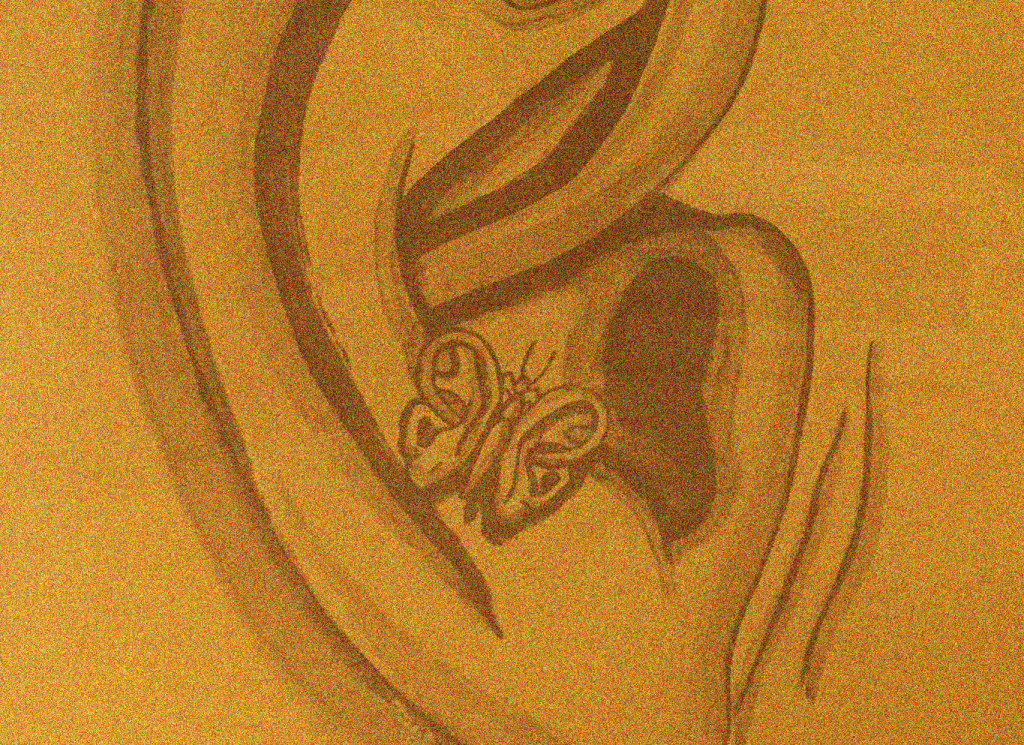
58
Sarah Margnetti
THIRD EAR
December 9, 2022 to March 25, 2023
Opening times : 24/24, from Mondays to Sundays
THIRD EAR
For her exhibition at the KMD, Sarah Margnetti creates a «mise en abyme»; an ear in the ear, not one of reason or rationality, but one based on unconscious listening. A pair of ears placed in the lakes direction in which whispers an (ear-)butterfly, symbol of rebirth.
Mastering the «trompe-l’oeil» technique, Sarah Margnetti has developed a pictorial style combining optical illusions and abstract forms. These motifs, representing fragments of bodies, emerge or merge into elements of architecture or furnishings inspired by the theater world.
Acrylic painting under glass with brass frame.
Dimensions: 16 x 24 cm.
—
THIRD EAR (FR)
Pour son exposition à la KMD Sarah Margnetti nous propose une mise en abyme; l’oreille dans l’oreille, non pas celle de la raison ou de la rationalité, mais celle de l’écoute basée sur l’inconscient. Une paire d’oreilles placée en direction du lac dans laquelle vient murmurer un papillon(-oreilles) symbole de renaissance.
Maîtrisant la technique du trompe-l’œil, Sarah Margnetti a développé un style pictural qui combine illusions d’optique et formes abstraites. Ces motifs représentant des fragments de corps, surgissent ou se fondent dans des éléments d’architecture ou d’ameublement tirés du monde du théâtre.
Peinture acrylique sous verre avec cadre en laiton.
Dimensions : 16 x 24 cm.
After her Bachelors degree in Visual Arts from the École Cantonale d’Art de Lausanne, Sarah Margnetti follows the Work Master at the Haute École d’Art et de Design de Genève before continuing her training in Brussels, at the Van der Kelen-Logelain Institute, dedicated to the study of decorative painting.
—
Suite à son Bachelor en Arts Visuels de l’École Cantonale d’Art de Lausanne, Sarah Margnetti suit le Work Master de la Haute École d’Art et de Design de Genève avant de poursuivre sa formation à Bruxelles, à l’Institut Van der Kelen-Logelain, dédié à l’étude de la peinture décorative.

57
Jacques Duboux
AXCEL
July 9 to November 19, 2022
Opening times: 24/24, from Mondays to Sundays
AXCEL
The Axcel exhibition consists of a zoomorphic bronze object, whose geometry follows the circumference of the KMD. This oxidized figure opens onto a troubled and grating mythology. Behind it, a stroboscopic projection produces a form of anachronism that detaches it from its environment.
In his work, Jacques Duboux collaborates with craftsmen who also make functional objects, whether for the domestic sphere or for industry. This approach confers an ambiguous aesthetic to his productions: marked by a form of surrealism, but familiar in their construction.
Materials: Silicon bronze, verdigris, stroboscope.
—
AXCEL
L’exposition Axcel est constituée d’un objet zoomorphe en bronze, dont la géométrie suit la circonférence de la KMD. Cette figure oxydée ouvre sur une mythologie trouble et grinçante. Derrière elle, une projection stroboscopique produit une forme d’anachronisme qui la détache de son environnement.
Dans son travail, Jacques Duboux collabore avec des artisans qui réalisent également des objets fonctionnels, que cela soit pour la sphère domestique ou pour l’industrie. Cette démarche confère une esthétique ambiguë à ses productions: empreintes d’une forme de surréalisme, mais familières de par leur facture. Matériaux : Bronze au silicium, vert-de-gris, stroboscope.
Born in 1982 in Lausanne (CH), Jacques Duboux lives in Vevey and works in Riex. After his exhibition Koover at zqm in Berlin, he joined the Pro Helvetia residency program at CCI Fabrika in Moscow during the end of 2021. A graduate in Visual Arts from ECAL, he is developing a sculptural practice, whose series Dynamies led to a book published by TSAR Editions in 2018. He was also part of the artist-run space STADIO, that he co-founded in Vevey in 2014. (www.jacquesduboux.com)
—
Né en 1982 à Lausanne (CH), Jacques Duboux vit à Vevey et travaille à Riex. Après son exposition Koover à zqm, Berlin, il rejoint le programme de résidence Pro Helvetia au CCI Fabrika à Moscou, fin 2021. Diplômé de l’ECAL en arts visuels, il développe une pratique sculpturale, dont la série Dynamies aboutira à un livre publié par les éditions TSAR en 2018. Il a également fait partie de l’espace d’artistes STADIO, qu’il a cofondé à Vevey en 2014. (www.jacquesduboux.com)
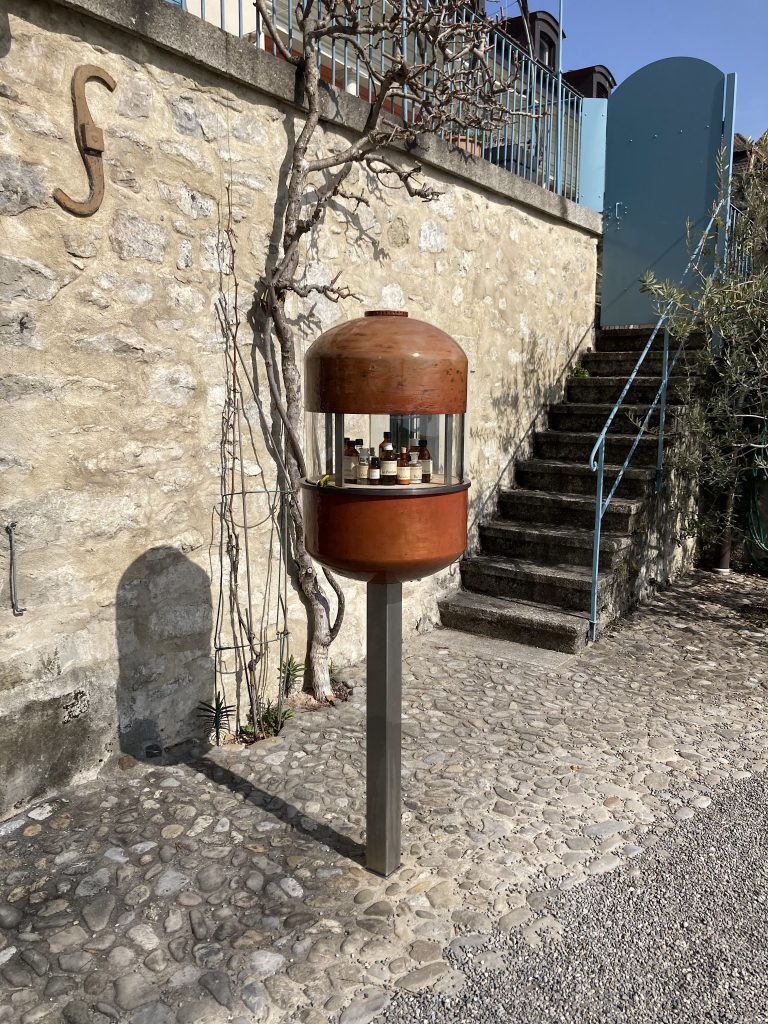
56
Peter Wüthrich
LA PHARMACIE DE PLATON (Plato’s Pharmacie)
March 19 to July 9, 2022
Opening times: 24/24, from Mondays to Sundays
Plato’s Pharmacie
Two of the artist’s works are temporarily united here. On the upper floor — «Literary Pharmacy» — consists of eighteen bottles whose labels correspond to various literary works. On the lower floor — «Plato’s Love» — consists of two intertwined miniature books.
By free association, these two works refer to the epony- mous title of the book by philosopher Jacques Derrida, founder of the philosophy of deconstruction. But above all, the title refers to Marcel Duchamp’s «Pharmacy», which was his first «readymade» work.
The spiritual healing effect of literature is thus associa- ted with Plato’s philosophical theory of love (Eros).
The cave, the formal archetype of the maternal womb, harkens back to the idea of the origins of life as well as of sensible appearances, according to the Platonic allegory of the cave. Grottoes, in turn, are the sites where the earliest records of artistic expression by humans can be found.
—
La Pharmacie de Platon
Deux oeuvres de l’artiste se retrouvent ici réunies temporairement. À l’étage supérieur — «Pharmacie littéraire» — composée de dix-huit flacons dont les étiquettes cor- respondent à des oeuvres littéraires variées. À l’étage inférieur — «Amour de Platon» — se compose de deux livres miniatures entrelacés.
Par association libre, ces deux oeuvres font référence au titre éponyme du livre du philosphe Jacques Derrida, fondateur de la philosophie de la déconstruction. Mais surtout, le titre fait référence à la «Pharmacie» de Marcel Duchamp, sa première oeuvre «readymade».
L’effet curatif spirituel de la littérature s’associe ainsi à la théorie philosophique de l’amour (Eros) de Platon.
Peter Wüthrich was born in 1962 in Bern. Since the early 1990’s, Peter Wüthrich’s art has focused exclusively on the medium of the book. His works ranges from wall pieces and installations to photographs and films, seing books as personalities which are open to a transformation into another form of reality.
www.peterwuethrich.ch
—
Peter Wüthrich est né en 1962 à Berne. Dès le début des années 1990, l’artiste investit exclusivement le support du livre. Ses œuvres, variées, vont du mural à l’installation, en passant par la photogrpahie et la vidéo. Il considère les livres comme des êtres pouvant prendre une autre forme de réalité.
www.peterwuethrich.ch

55
Nils Nova
FACING THE SUN (Face au soleil)
September 20, 2021 to Mars 19, 2022
Opening times: 24/24, from Mondays to Sundays
Facing the Sun
A small oil painting on wood, painted on both sides, stands like a sculpture in the Kunsthalle. On the one hand, the painting is strongly geometric, offering a minimalist and abstract pictorial language, but on the other hand, it is also a figurative image that evokes a bright and colorful space.
On the lower floor of the Kunsthalle, a « memory painting » is installed, as a landscape. The canvas, covered with overlapping drops and patches of color, was created over a long period of time as an « echo of the image » on the upper floor.
Nils Nova was born in 1968 in Sant Ana, El Salvador. In 1981 he moved to Switzerland with his Swiss mother and Salvadorian father. After being trained as boat builder, he studied from 1997 to 2001 at the Lucerne University of Art and Design. He currently lives and works in Lucerne.
“With my paintings, I try to create a kind of meta mirror, a projection surface where everything becomes possible, and where one is facing both the inner and the outside world.
Today, our lives are flooded with images. Every day we swipe and click our way through thousands of images, creating some kind of indistinct noise in our heads. My paintings deal with this medial overexposure and how images are superimposed onto one another. Paradoxically perhaps, the daily flood of information also brings about a new kind of calm. Something similar happens in my painting process. If I am restless and start to paint, I try to reach a meditative state while painting. However, there is always the possibility of failing. It is out of this tension between the possibility of failing and the attempt to achieve my inner calm that my paintings are born. I often lay a canvas on the floor underneath the canvases I paint. While I am painting, fresh paint drips from my brush leaving stains on the canvas on the floor. These stains multiply painting after painting. In this way the canvas on the floor becomes a mirrored image of my paintings – A mirror, so to speak, of my painted meta mirrors.”
Excerpt from the short-film Inside Nils Nova by Christof Schuerpf (2021)
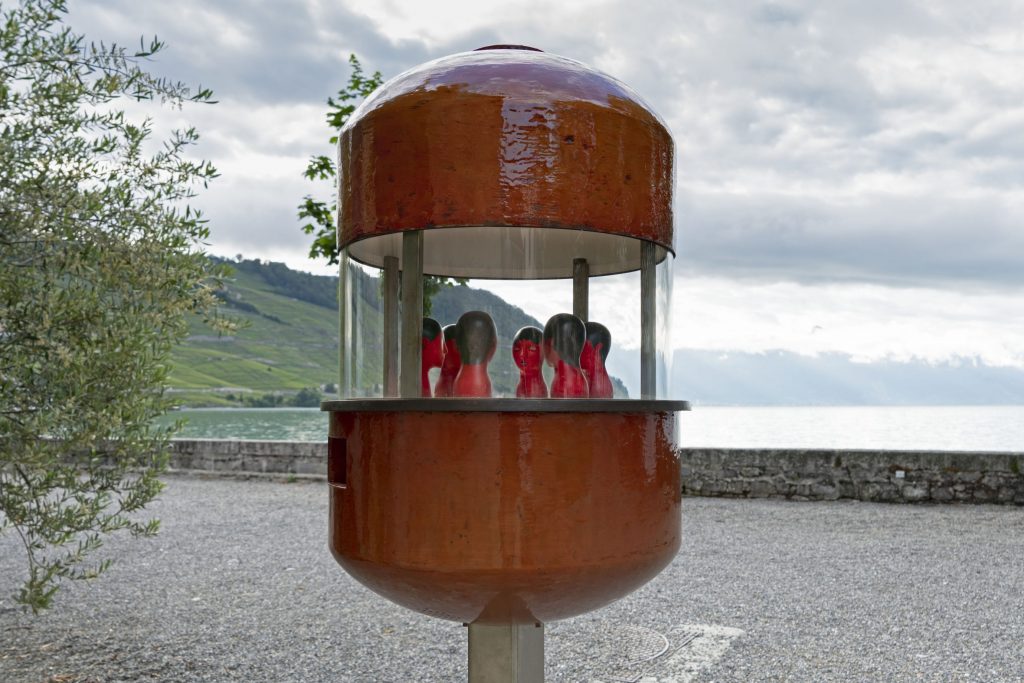
54
Nicolas Party
HEADS AND CAVE (Têtes et Grotte)
June 22 to September 19, 2021
Opening times: 24/24, from Mondays to Sundays
Six heads and a blue cave
Text by Nicolas Party
The six heads don’t have any particular expressions and feel unhuman, each head only staring at the gaze of the heads placed in front of it. The appearance of the heads echoes two distinctive times in western culture: on one hand, the faces suggested the classic Greek sculpture esthetic, where proportion and lines are idealized to create an unrealistic portrait. On the other hand, the heads point to the present time and to our way of transforming the human face through digital photo filters, make-up as well as plastic surgery. Comparable to the inaccessible idea of beauty by the Greek, our modern way to transform the esthetic of our appearance constantly seems to be inaccessible.
The painting of the blue cave is based on an imaginary deeply rooted in various civilizations and cultures. The cave, the formal archetype of the maternal womb, harkens back to the idea of the origins of life as well as of sensible appearances, according to the Platonic allegory of the cave. Grottoes, in turn, are the sites where the earliest records of artistic expression by humans can be found.
Nicolas Party (*born in Lausanne in 1980) is based in New York. He studied at ECAL/University of Art and Design Lausanne in Switzerland before receiving his MFA from Glasgow School of Art in Scotland.
Party is a figurative painter who has achieved critical admiration for his familiar yet unsettling landscapes, portraits, and still lifes that simultaneously celebrate and challenge conventions of representational painting. His works are primarily created in soft pastel, an idiosyncratic choice of medium in the 21st-century, and one that allows for exceptional degrees of intensity and fluidity in his depictions of objects both natural and manmade. Among other mediums, Party also creates sculptures such as painted busts and body parts that allude to the famous fragments of ancient Greece and Rome. His brightly-colored androgynous figures vary in scale from the handheld to the monumental.
The artist’s childhood in Villette (Lavaux, Switzerland) imprinted upon him an early fascination with landscape and the natural world, and the influence of his native country places Party firmly within the trajectory of central European landscape painting. Points of reference in his work include celebrated 19th-century Swiss artists Félix Vallotton, Ferdinand Hodler and Hans Emmenegger.
Nicolas Party has a current exhibition at MASI in Lugano, Switzerland and forthcoming one at Le Consortium in Dijon, France.
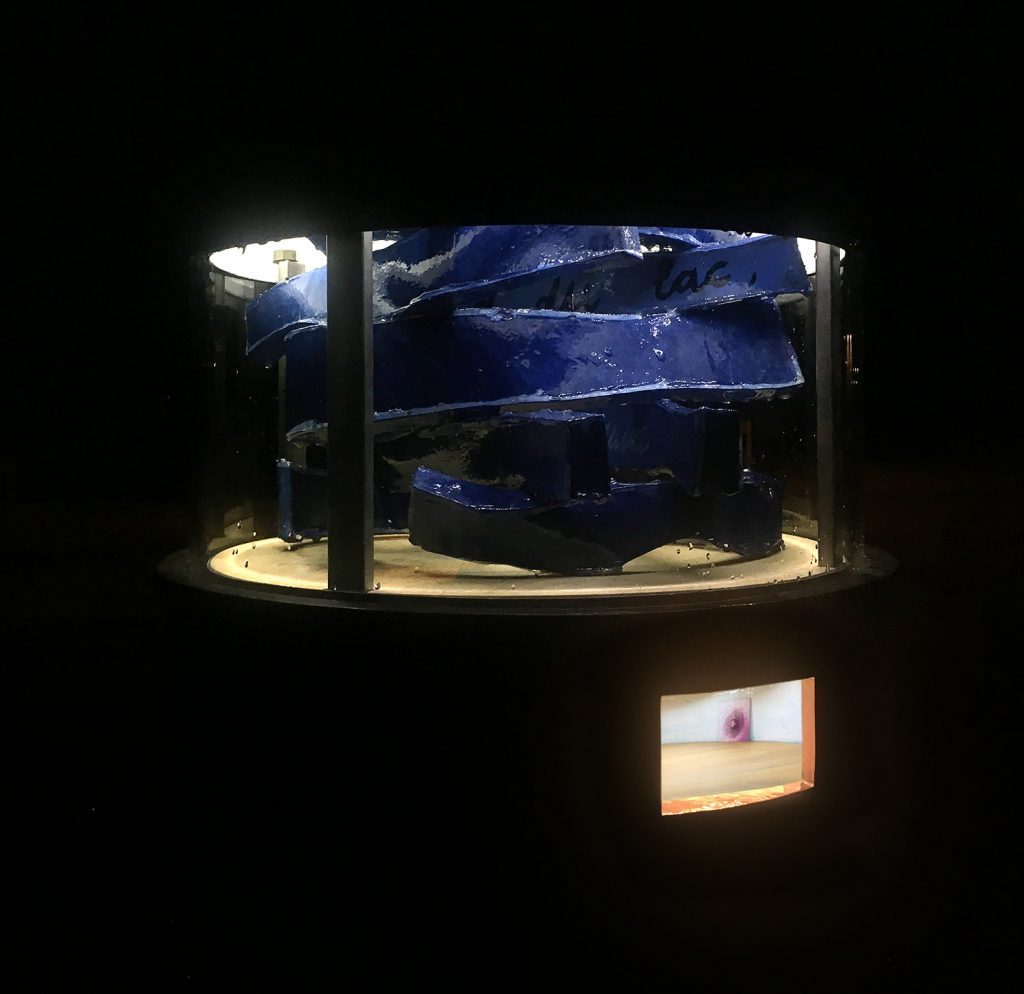
53
Simone Holliger | Mathieu Dafflon
UNE FORME DE GRAND PLAISIR, SEUL (A Form of Great Pleasure, Alone)
March 31 to June 20, 2020
Opening times: 24/24, from Mondays to Sundays
Simone Holliger and Mathieu Dafflon met during their studies at HEAD in Geneva. Today they live in Basel together with their daughter Tilda.
Simone Holliger’s artistic practice is based in the fields of sculpture and installation. She primarily uses paper as a flexible and sometimes unpredictable construction material, playfully reinterpreting a vocabulary of forms inspired by modern sculpture.
Mathieu Dafflon’s starting point for his artistic work is the overflowing and almost inexhaustible visual material of conventional and digital media, to which he gives a new identity through selection, decontextualization and painterly transformation. Since 2019, he has also been sending small-format paintings by mail as an alternative form of dialogue between artist, artwork, and viewer.
In Une Forme de grand plaisir, seul, the two artists are now attempting to realize a joint exhibition for the first time with their different forms of artistic expression. The invitation of the KMD has motivated them at the same time to address the art of Marcel Duchamp. The exhibition title Une Forme de grand plaisir, seul is a quotation from one of the six interviews that Georges Charbonnier conducted with Duchamp in December 1960 and January 1961 for French radio and which were published in 1994 by André Dimanche in Marseille.
In the realization of their exhibition, the question of how exactly to place their own working methods in resonance with Duchamp’s work was particularly important. The notions of “relationship“ and “body“ have played an important role and culminated in Holliger’s sculpture Foyer (paper, glue, acrylic ink, and epoxy resin), on the one hand, and Dafflon’s diptych Golden Hours (oil on cardboard covered with canvas) on the other.
Foyer is a playful exploration of Duchamp’s readymade Bottlerack. Holliger has inscribed her object with words on the inside, among other things, which at the same time remain “hidden in the intimacy of the interior space created“ for the viewer. With this procedure, Holliger is responding specifically to Duchamp’s mysterious sentence, which he wrote on the inside of the readymade in Paris in 1915, immediately before he moved to New York. It no longer exists today because his sister Suzanne disposed of the Bottlerack while cleaning up the studio and Duchamp later remembered neither the wording nor the content of the formulation (at least that is how the legend has it).
Mathieu Dafflon, for his part, takes as his starting point the object Prière de toucher, which Duchamp created for the cover of the catalog Le Surréalisme in 1947. He transfers Duchamp’s female breast, which we automatically touch when we consult the catalog, to the painting of two nipples, one male the other female, which we look at without touching them, thus making a voyeuristic wink at Étant donnés.
Simone Holliger, born in 1986 in Aarau, lives and works in Basel. Studied visual arts in Lucerne and then at the HEAD in Geneva, where she received her MA in 2014. Solo exhibitions (selection): Kunstraum Riehen (2020), Oxyd Kunsträume, Winterthur (2019), Body&Soul, Geneva (2018), Salle Crosnier, Geneva (2017). Group exhibitions (selection): Kunstmuseum Solothurn (2021, forthcoming), Kunsthalle St. Gallen (2020), Prix mobilière, Art Genève (2020), Swiss Art Awards, Basel (2019). Prizes and residencies (selection): Atelier Berlin, FCAC Geneva (2020), Swiss Art Award (2019), Förderpreis, Neue Aargauer Bank (2018).
Mathieu Dafflon, born in 1987 in Geneva, lives and works in Basel. Studied visual arts at the HEAD in Geneva and at the Maryland Institute College of Art in Baltimore. He currently lives and works in Basel where he co-founded the artist-run space Palazzina. His paintings have been exhibited in various art spaces in Switzerland including Galerie Wilde, Geneva (2019), Sonnenstube, Lugano (2018) and Last Tango, Zurich (2020).
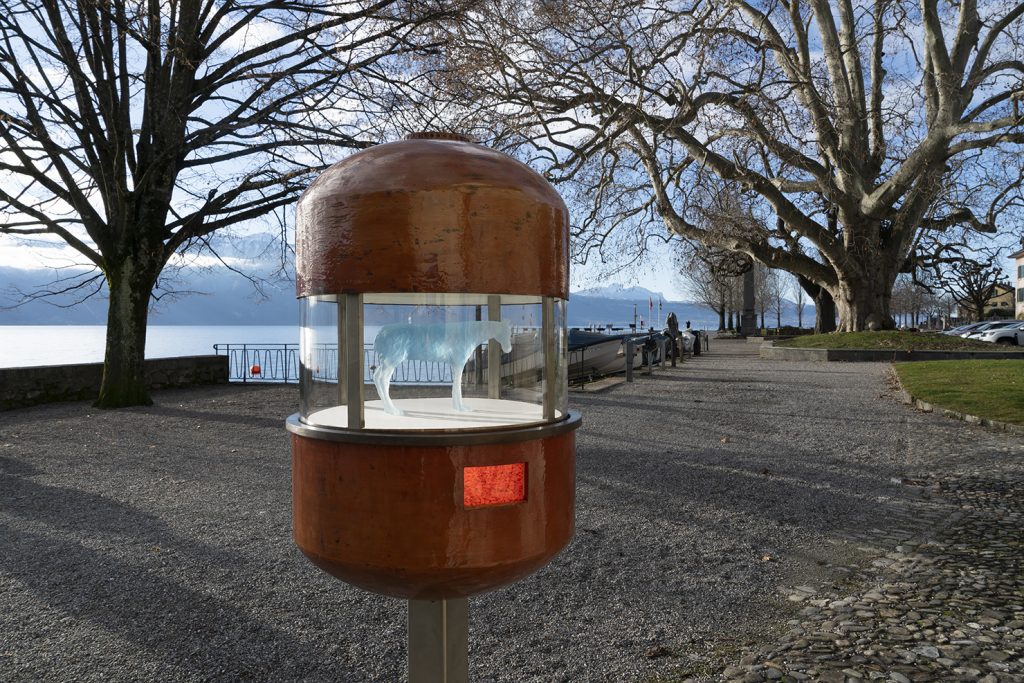
52
Ugo Rondinone – feeling the void and the rhone
January 15 to March 15, 2021
Opening times: 24/24, from Mondays to Sundays
The exhibition feeling the void and the rhone by internationally renowned and New York-based Swiss artist Ugo Rondinone consists of, on the one hand, a floor surface covered with orange-red gravel titled feeling the void (gravel, paint, 41.3 x 41.3 cm, 2012) on display in the basement, and, on the other hand, a blue glass horse titled the rhone (glass, 17 x 26 x 6 cm, 2017) on the transparent upper floor of the museum. Be sure to visit the exhibition at Quai de l’Indépendance in Cully. It not only holds challenging, perceptual-poetic questions for the viewer, but is especially a touching visual experience.
Ugo Rondinone was born in 1962 in Brunnen, Switzerland, and lives and works in New York. Rondinone has been the subject of recent institutional exhibitions at: Medellín Museum of Modern Art, Colombia; Kunsthalle Helsinki, Finland; and Guild Hall, East Hampton, New York in 2019; Fundación Casa Wabi, Puerto Escondido, Mexico; Arken Museum of Modern Art, Ishøj, Denmark; and Tate Liverpool, UK in 2018; Bass Museum of Art, Miami; Berkeley Art Museum and Pacific Film Archive, Berkeley, California; Contemporary Arts Center, Cincinnati, Ohio; and Garage Museum of Contemporary Art, Moscow in 2017. In 2016, Rondinone’s large-scale public work seven magic mountains opened outside Las Vegas, co-produced by the Art Production Fund and Nevada Museum of Art. In 2017, Rondinone curated a city-wide exhibition, “Ugo Rondinone: I ❤ John Giorno,” which was presented in twelve New York non-profit institutions: Artists Space, High Line Art, Howl! Happening, Hunter College Art Galleries, the Kitchen, New Museum, Red Bull Arts New York, Rubin Museum of Art, SkyArt, Swiss Institute, White Columns and 80WSE Gallery. Recent and forthcoming exhibitions include: Esther Schipper, Berlin; Galerie Eva Presenhuber, Zurich; Sant’Andrea de Scaphis, Rome; SKMU Sørlandets Kunstmuseum, Kristiansand; Sadie Coles HQ, London, Schirn Kunsthalle, Frankfurt; Belvedere 21, Vienna; Galerie Krobath, Vienna; Museo Tamayo, Mexico City, and the Phillips Collection, Washington, D.C.
Photographs from the entire exhibition See or download pdf
Florence Millioud Henriques on Ugo Rondinone’s exhibition in 24heures on January 16, 2021: Paper version | Digital version

51
Marcel Duchamp – Baptism
In collaboration with Caroline Tschumi, Caroline Bachmann, and Stéphane Zaech
Curated by Stefan Banz
November 15, 2020, to January 10, 2021
Opening times: 24/24, from Mondays to Sundays
Photographs from the entire exhibition See or download pdf
Exhibition information Read or download pdf
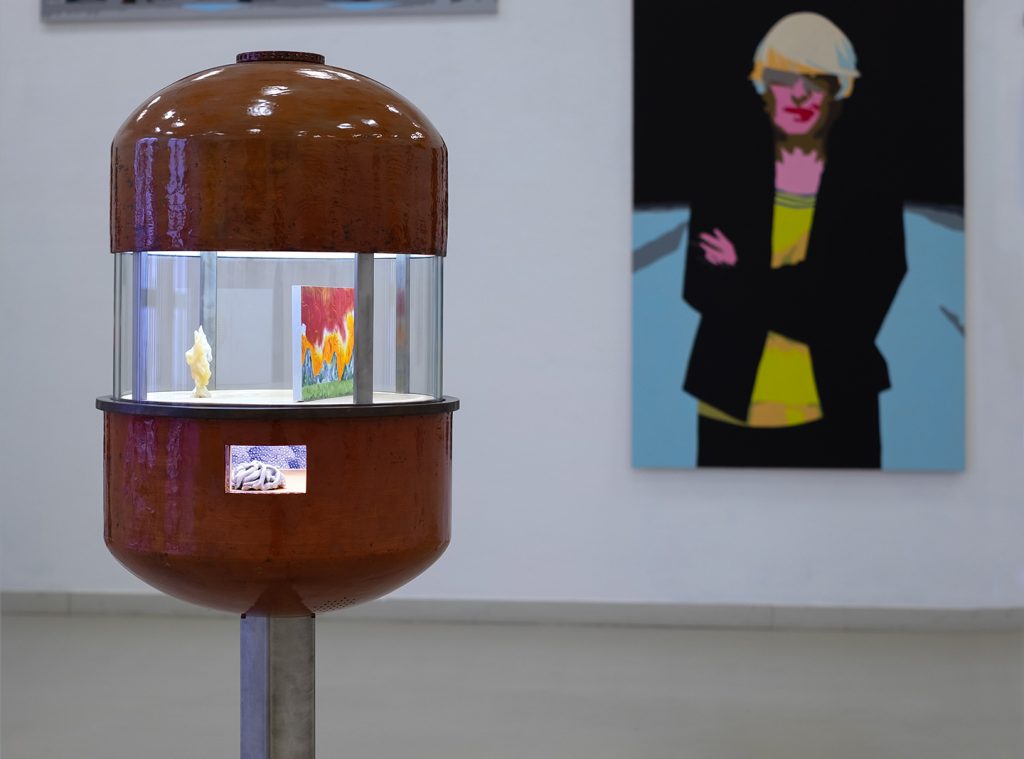
50
KMD invited by
(EAC) Les Halles, Centre d’Art, rue Pierre-Péquignat 9, 2900 Porrentruy, Switzerland
Exhibition:
Sébastien Strahm and Philippe Queloz
At the same time on the walls of the exhibition space:
One man show by Stefan Banz — We Have Been in Truth: New Paintings
February 9 to March 31, 2019
Information:
On the exhibition of Sébastien Strahm and Philippe Queloz Read or download pdf in French
On Stefan Banz’s solo show French | German
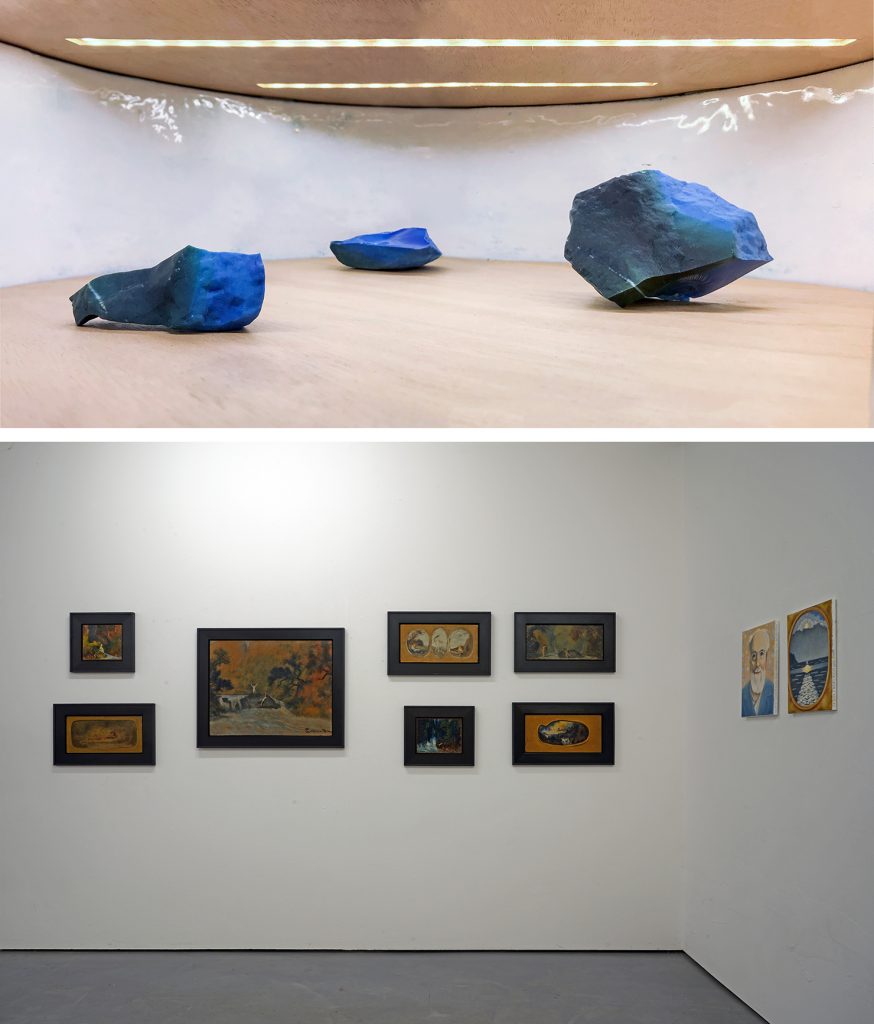
48 & 49
KMD AT 8. SALON E.V., TROMMELSTRASSE 7, 20359 HAMBURG
Invited by Roberto Ohrt
On the walls:
Louis Michel Eilshemius (1864–1941) – Most Rapid Master Painter and Lord Chancellor of the Art World
An exhibition by Stefan Banz, with an intervention and additional works by Caroline Bachmann
In the exhibition room:
KMD — Kunsthalle Marcel Duchamp | The Forestay Museum of Art
With the exhibition Bruchstücke einer Aussicht
by Jonathan Banz and Nicolò Krättli
Opening with book launch, Friday, September 7, 2018, 6:30 pm
Stefan Banz (ed.), Louis Michel Eilshemius: Six Musical Moods
Book with integrated music CD; music for piano, performed by Imke Lichtwark; with texts by Roberto Ohrt, Sven Daigger, Stefan Banz and Louis Michel Eilshemius; english | deutsch; 176 pages, 74 illustrations; Verlag für moderne Kunst, Vienna, and Les Presses du réel, Dijon, 2018
September 8 to October 21, 2018

47
Philippe Fretz and Stéphane Zaech
One Size Fits All – A Homage to Frank Zappa
Concept by Stefan Banz
June 10 to August 19, 2018
Opening times: 24/24, from Mondays to Sundays
Exhibition information Read or download pdf

46
Peter Schärli (Trumpet), Pierre Favre (Drums)
Alpsegen
Video installation during the Cully Jazz Festival 2018
Opening of the exhibition with a free concert by the two musicians: Friday, April 13, 2018, 6 pm
Opening times: From 9 am to 11.30 pm, from Mondays to Sundays
Electronics and installation by Yannick Soller
Video by Markus Mäder, Jonas Ruppen and Stefan Banz
Recorded by Ron Kurz
Performned at Bau4, Altbüron, Switzerland, September 2017
Watch the video Alpsegen
Exhibition information Read or download invitation
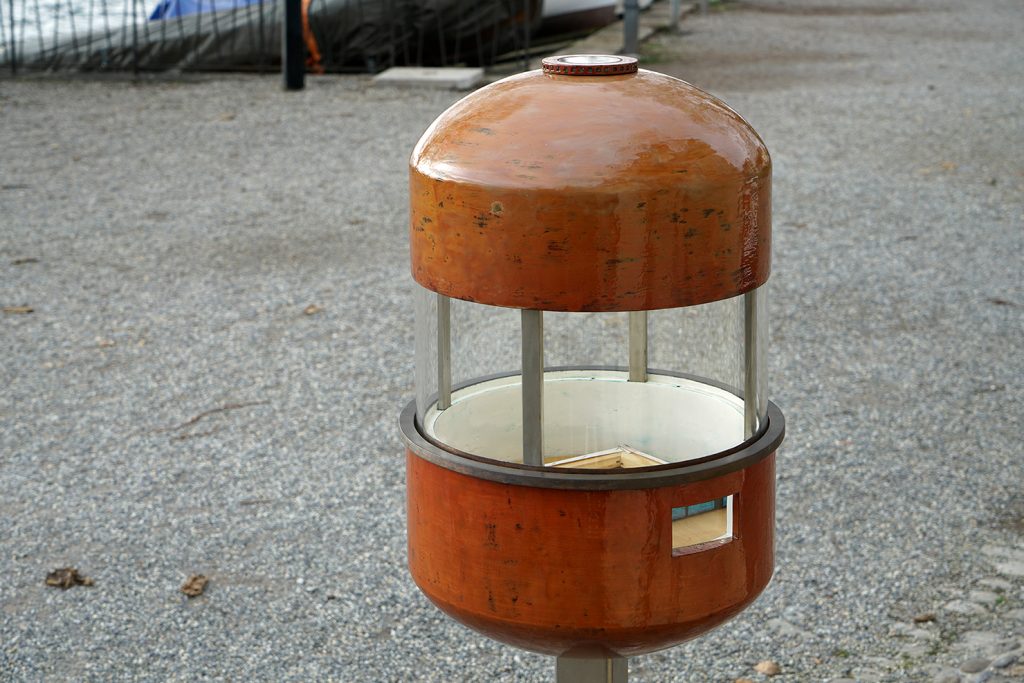
45
Grégory Sugnaux
Fatigue, c’est la vie
January 28, 2017 to April 8, 2018
Opening times: 24/24 from Mondays to Sundays
Exhibition information Read or download pdf
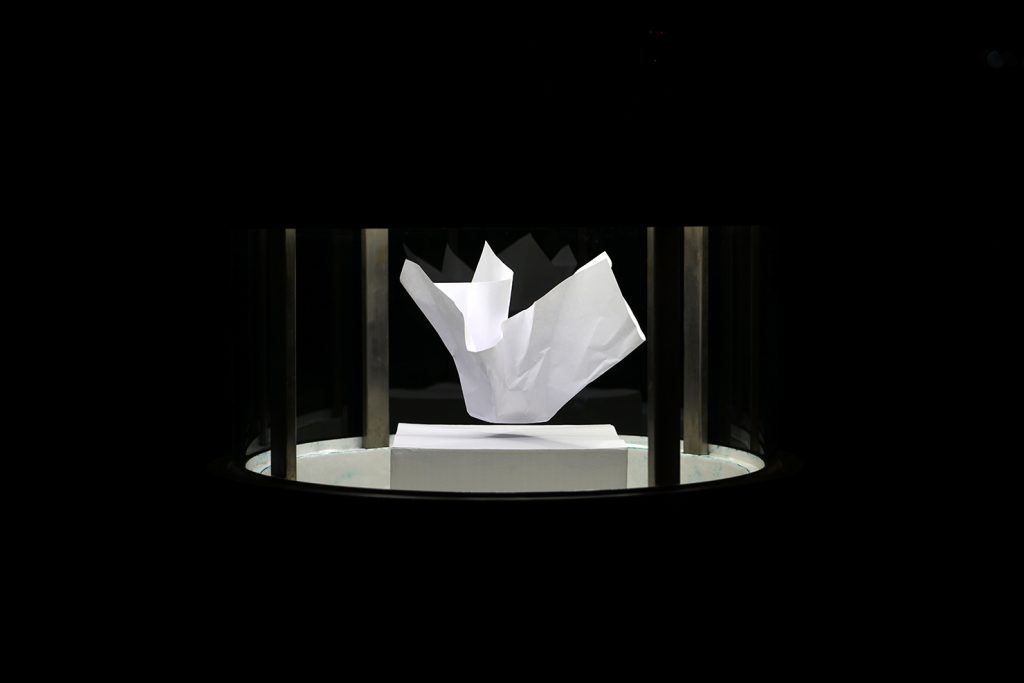
44
Serkan Özkaya
White on White
November 18, 2017 to January 7, 2018
Opening times: 24/24 from Mondays to Sundays
Supported by Canton de Vaud
Exhibition information Read or download pdf

43
One Hundred Years of Marcel Duchamp’s Fountain
Ecke Bonk — Pierre Cabanne — William A. Camfield — Thierry de Duve — Marcel Duchamp — Marsden Hartley — Walter Hopps — Ulf Linde — Heinz Herbert Mann — Helen Molesworth — Henri-Pierre Roché — Arturo Schwarz — Alfred Stieglitz — Beatrice Wood
An exhibition by Stefan Banz and Caroline Bachmann
Museum Cultuur, Strombeek, Gent
Cultuurcentrum Strombeek, Grimbergen-Bever, Belgium
October 27, 2017 to April 1, 2018
Opening times: 24/24 from Mondays to Sundays
Supported by Stanley Thomas Johnson Foundation
Exhibition information Read or download pdf

42
Matthias Sohr
Tondo
September 3 to November 12, 2017
Opening times: 24/24 from Mondays to Sundays
Supported by
Canton de Vaud, and Sunrise Medical, Switzerland
Exhibition information: Read or download pdf

41
One Hundred Years of Marcel Duchamp’s Fountain
Ecke Bonk — Pierre Cabanne — William A. Camfield — Thierry de Duve — Marcel Duchamp — Marsden Hartley — Walter Hopps — Ulf Linde — Heinz Herbert Mann — Helen Molesworth — Henri-Pierre Roché — Arturo Schwarz — Alfred Stieglitz — Beatrice Wood
An exhibition by Stefan Banz and Caroline Bachmann
July 16 to August 27, 2017
Opening times: 24/24 from Mondays to Sundays
Supported by Stanley Thomas Johnson Foundation
Exhibition information Read or download pdf
Boris Senff on the exhibition in 24 heures, July 31, 2017
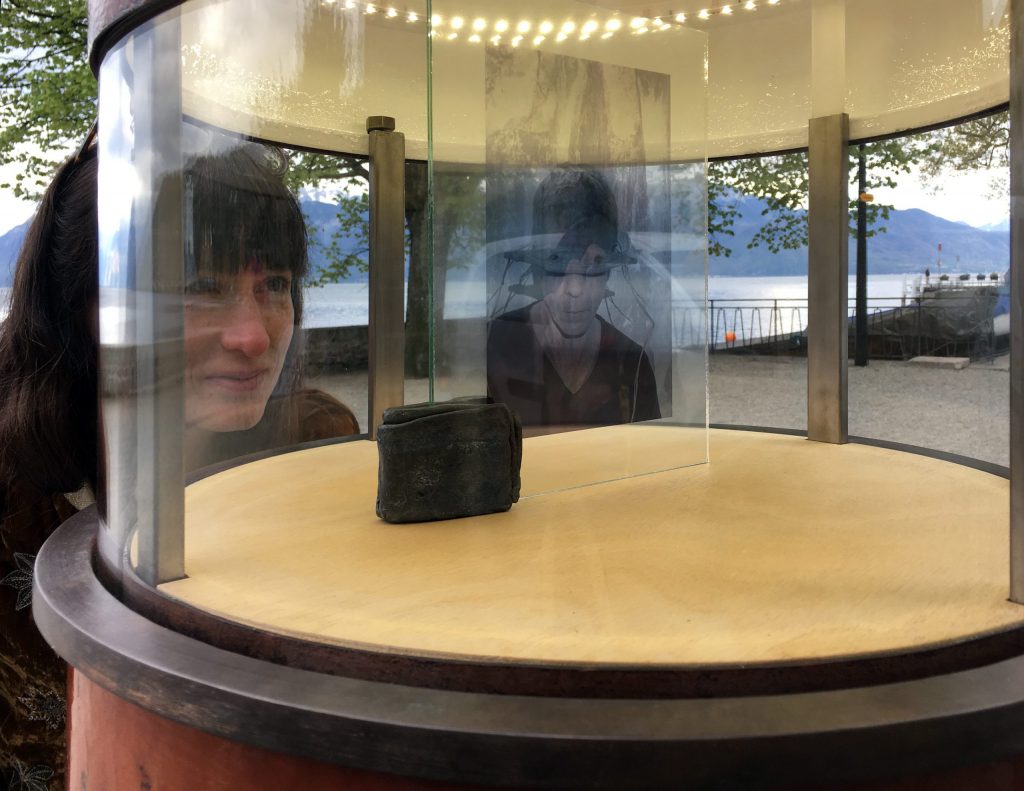
40
Alain Huck
Foin
April 23 to June 18, 2017
Opening times: 24/24 from Mondays to Sundays
Exhibition information Read or download pdf
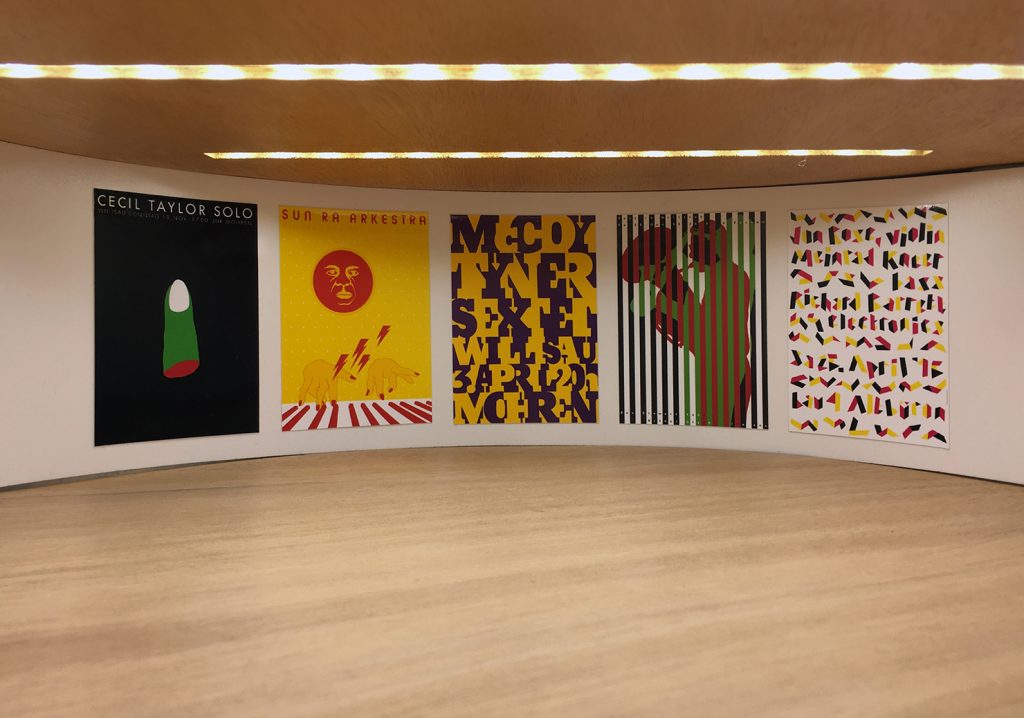
39
Niklaus Troxler
Les Affiches du Jazz à Willisau 1970–2016
March 31 to April 8, 2017 – During the Cully Jazz Festival
Opening times: 24/24 from Mondays to Sundays
Exhibition information Read or download pdf
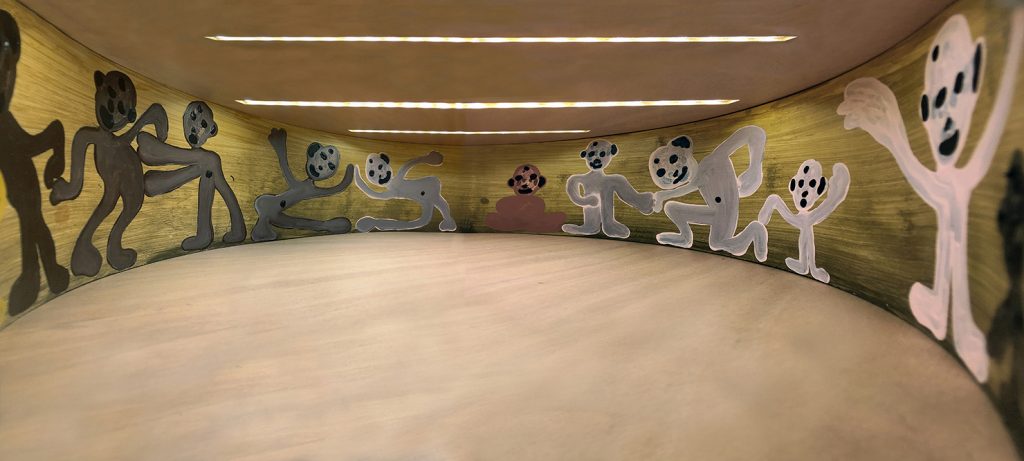
38
Philipp Schwalb
De.mSeignaAuzGangunendLichT
January 29 to March 26, 2017
Opening times: 24/24 from Mondays to Sundays
Exhibition information: Read or download pdf
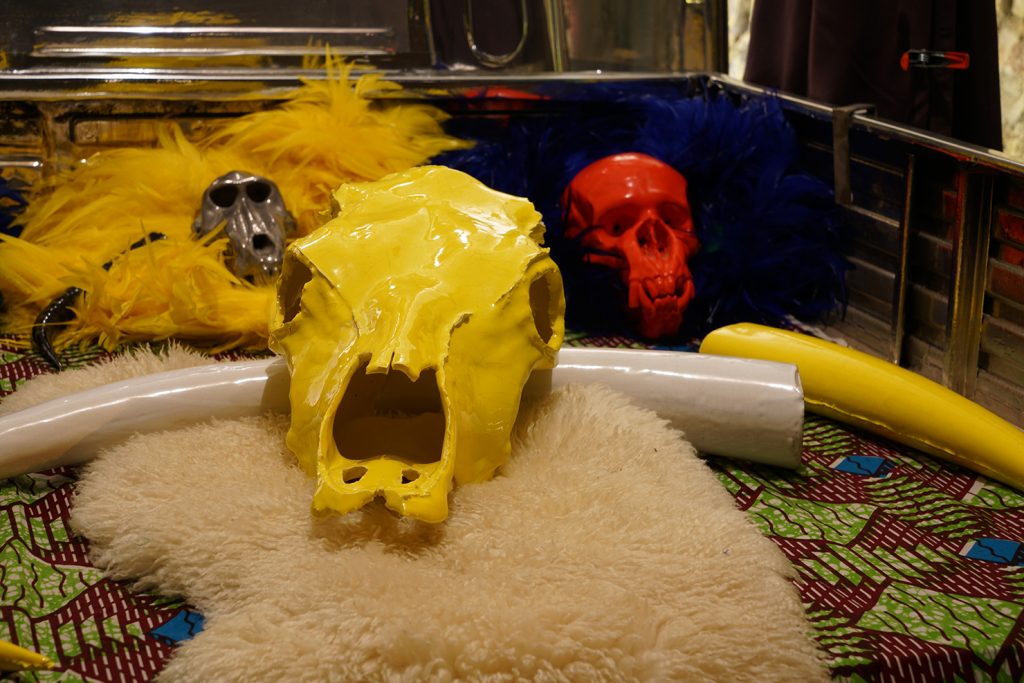
One Day Special Event
Exhibition during Cully Bazaar 2016
37
Boostage
Frédéric Post and Fabien Clerc in Daniel Ruggiero’s Urban Game Car
Sunday, December 4, 2016, at KMD Garage
Opening times: From 10 am to 6 pm
Exhibition information Read or download pdf
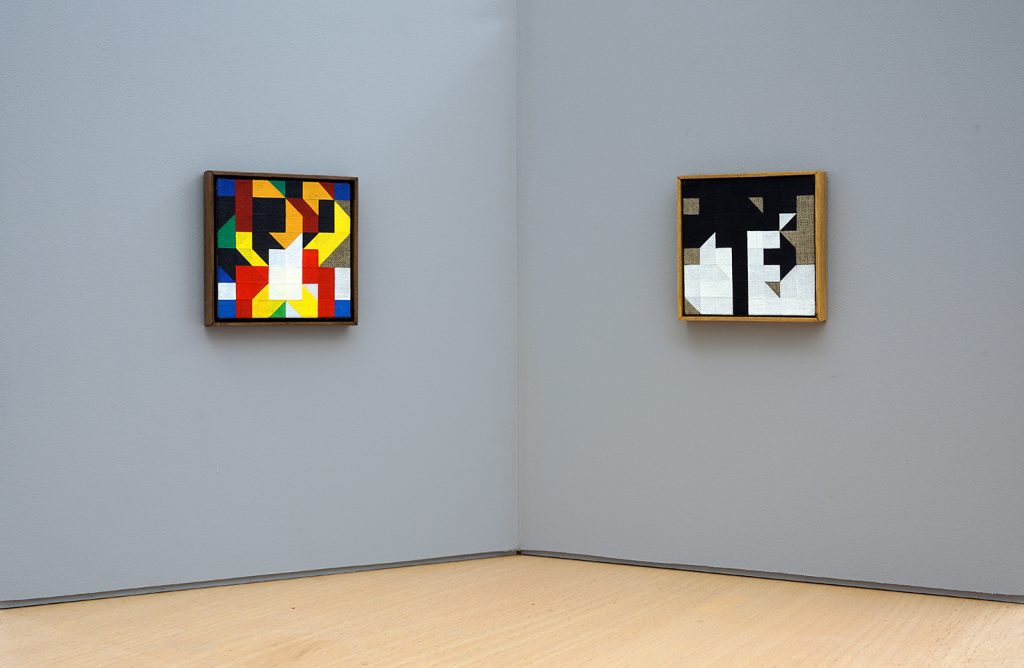
36
Tom Hackney
The Thought Game (Le Jeu mental)
November 20, 2016 to January 22, 2017
Opening times: 24/24 from Mondays to Sundays
Exhibition information: Read or download pdf
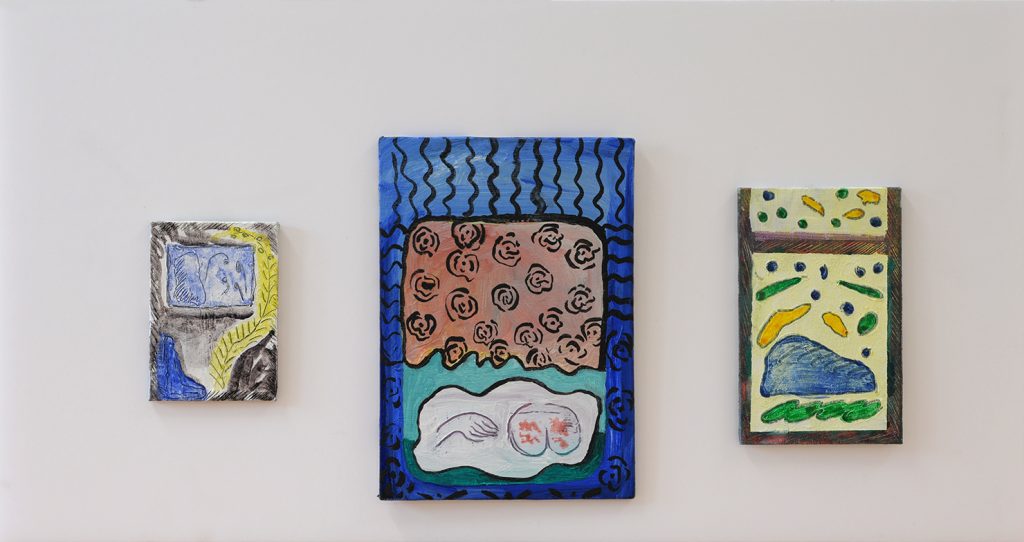
35
Zara Idelson
What Did the Clouds Look Like (A quoi ressemblaient les nuages)
September 25 to November 13, 2016
Opening times: 24/24 from Mondays to Sundays
Exhibition information Read or download pdf

34
Dialogue with Imaginary Viewers
Nin Brudermann – Stefan Brüggemann –Marcel Duchamp – Jérôme Hentsch –Cildo Meireles – Céline peruzzo
Curated by Stefan Banz
August 29 to September 21, 2016
opening times: 24/24 from mondays to sundays
Exhibition information Read or download pdf
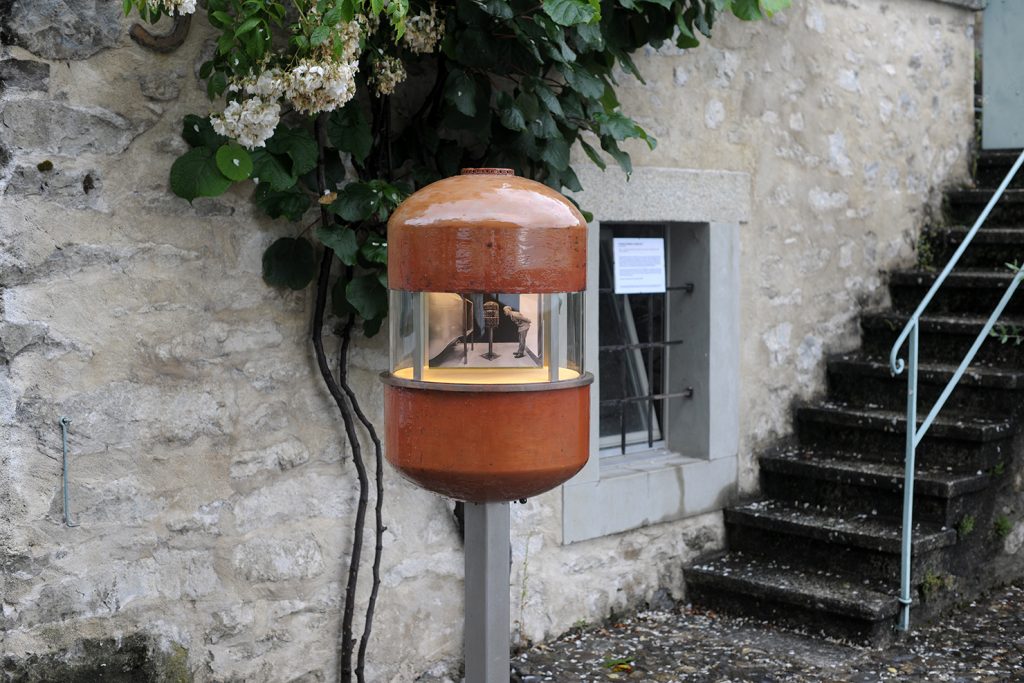
33
Florian Dombois – Inside Out
Which way does the wind blow when art meets viewer?
The new exhibition building of the KMD in the wind tunnel of the ZHdK Zurich
July 2 to August 28, 2016
Opening times: 24/24 from Mondays to Sundays
Exhibition information Read or download pdf

32
Inauguration of the new KMD exhibition building, designed by Jonathan Banz,
with the one woman show Karin Sander
May 14 to June 26, 2016
Opening times: 24/24 from Mondays to Sundays
Photographs of the inauguration and the exhibition See or download images
Information about the design of the new building Read or download pdf in English
Exhibition information Read or download pdf in French
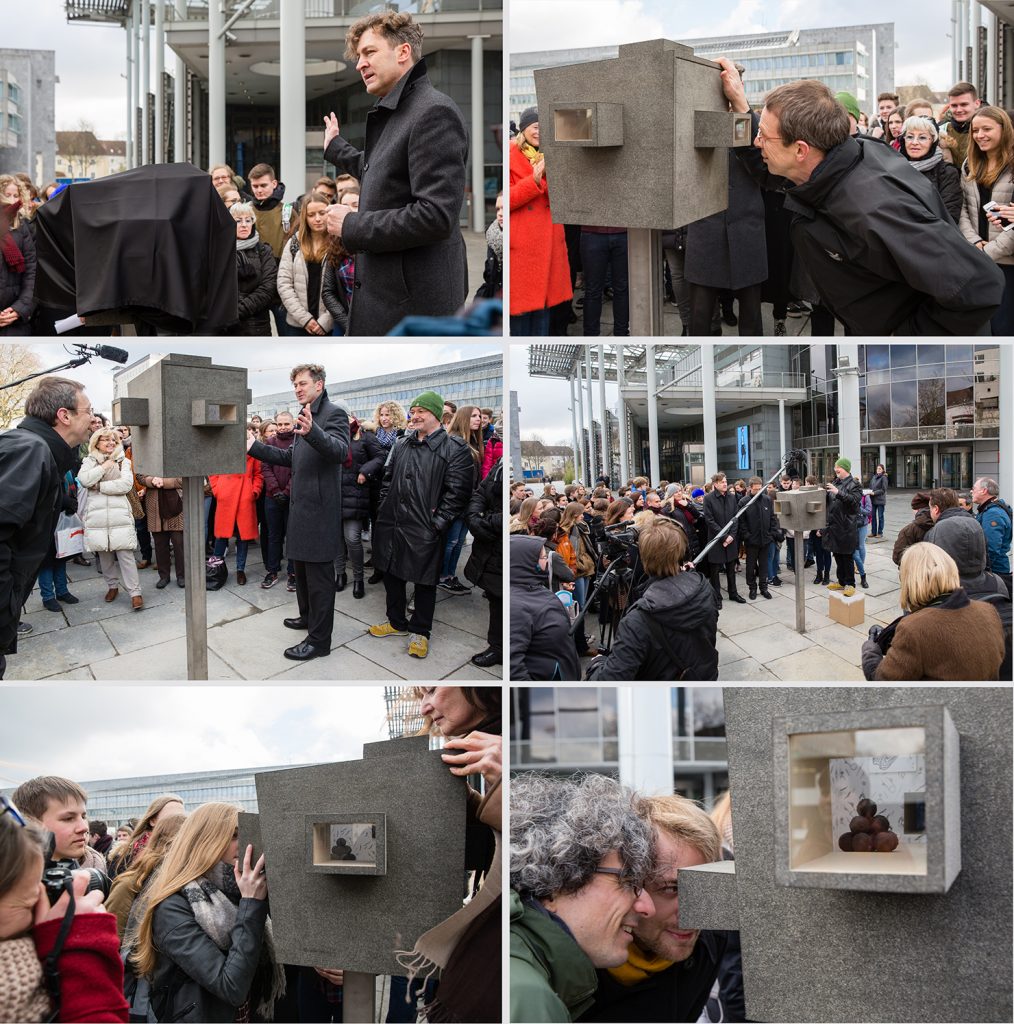
31
KMD in Wolfsburg
Caroline Bachmann | Stefan Banz – La Broyeuse de chocolat
Just opened: Kunsthalle Marcel Duchamp in Wolfsburg! At 11.15 pm on February 25, at the invitation of Ralf Beil,Director of the Wolfsburg Art Museum and in the presence of the artist Stefan Banz, the Mayor of the city of Wolfsburg, Klaus Mohrs, unveiled the new Kunsthalle Marcel Duchamp on Hollerplatz opposite the entrance to the Kunstmuseum Wolfsburg.
Hitherto the city of Wolfsburg has been able to boast at Art Museum, a Municipal Gallery, two registered Art Societies and an Art Showcase along the outside wall of the former municipal indoor swimming pool, now an Arts and Leisure Center. As of February 25, 2016, Wolfsburg’s cultural scene has now been augmented by a sixth institution: The KMD–Kunsthalle Marcel Duchamp.
What is unique about this new cultural amenity is that it is open to the public twenty-four-seven, shows a representative cross-section of masterpieces of the 20th and 21st centuries and no charge is made for admission.
Its content: 100 Years of Contemporary Art from Marcel Duchamp to Sonja Alhäuser. a large thematic presentation on two levels unites nine artists from five countries: Marcel Duchamp (fr), Meret Oppenheim (ch), Joseph Beuys (d), Dieter Roth (ch), Ed Ruscha (usa), Aldo Walker (ch), Robert Gober (usa), Vik Muniz (br) and Sonja Alhäuser (d).
But this is where it really scores: the Kunsthalle Marcel Duchamp, with its model architecture for unusual insights and perspectives, is just a quarter of a cubic meter in size. Indeed, it may claim to be the smallest, fully functional Art Museum in the world.
Conceived by the two Swiss artists Caroline Bachmann and Stefan Banz, the Kunsthalle Marcel Duchamp had been standing in Cully on the shore of lake Geneva since 2010 and had cast its spell on many visitor with such presentations as a Norbert Bisky Retrospective or Sunflower Seeds of Ai Weiwei (both original exhibitions especially made for the KMD by the invited artists). In 2013 it was a guest of the Mathildenhöhe Museum in Darmstadt, where it stood for a whole summer in front of the museum building, which in that year was closed for renovation. It was precisely for this occasion that the aforementioned presentation—and its accompanying comprehensive catalogue book—was conceived and realized. And now, thanks to a generous donation by CarolineBachmann and Stefan Banz, the Kunsthalle has now found a permanent home beneath the high entrance canopy of the Kunstmuseum Wolfsburg.
The catalogue book on the Kunsthalle Marcel Duchamp and its current exhibition, La Broyeuse de chocolat, has been edited by Caroline Bachmann, Stefan Banz and Ralf Beil and published by Verlag für moderne Kunst, Nuremberg: Hardcover, 336 pages, 14 x 10.5 cm, German-English, texts by Bradley Bailey, Stefan Banz, Ralf Beil, Martin R. Dean, Dalia Judovitz and Thomas Zaunschirm. Price: €20.
February 25, 2016 to February 26, 2017
Opening times: 24/24 from Mondays to Sundays
Exhibition information Read or download pdf in German
Press reviews Süddeutsche | Focus | Main Echo
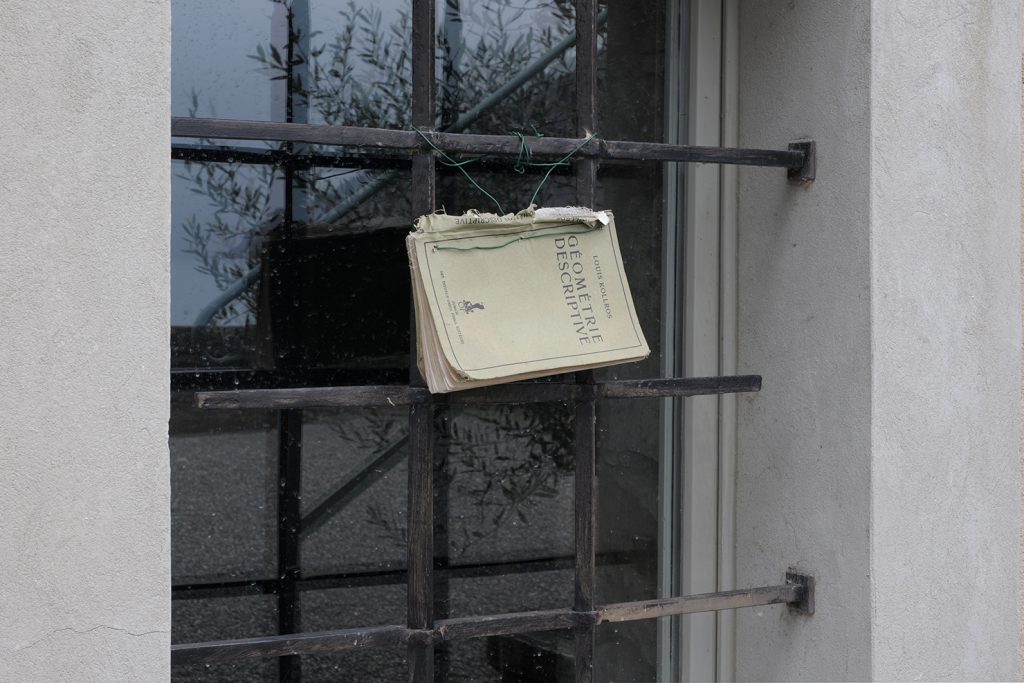
30
Special exhibition marking the occasion of Dada 100 Zurich:
Marcel Duchamp, The Unhappy Readymade 2016
Re-installation (replica) of Marcel Duchamp’s Ready-made malheureux, the instructions for which were cabled by the artist in Buenos Aires to his sister Suzanne Duchamp in Paris in 1919.
Directly behind the KMD, attached on the grid of the window of the immediately adjacent building at Place d’Armes 1, is a geometry textbook—Géometrie descriptive par Louis Kollros, professeur à L’école Politechnique Fédérale, published by Orell Füssli, Zurich 1918—which will remain exposed to the weather for the duration of the whole year.The wind will « go through the book, choose its own problems, turn and tear out the pages. » The sun and the rain will slowly decompose the knowledge contained in the book until it has ultimately returned to nature in its entirety.
The Unhappy Readymade will be on view the whole year through, every day, around the clock, and free of charge.
January 1 to December 31, 2016
Note: On April 28, 2016, the book disappeared. It was cut from the grid and stolen. In other words, The Unhappy Readymade ended in fact unhappily!
